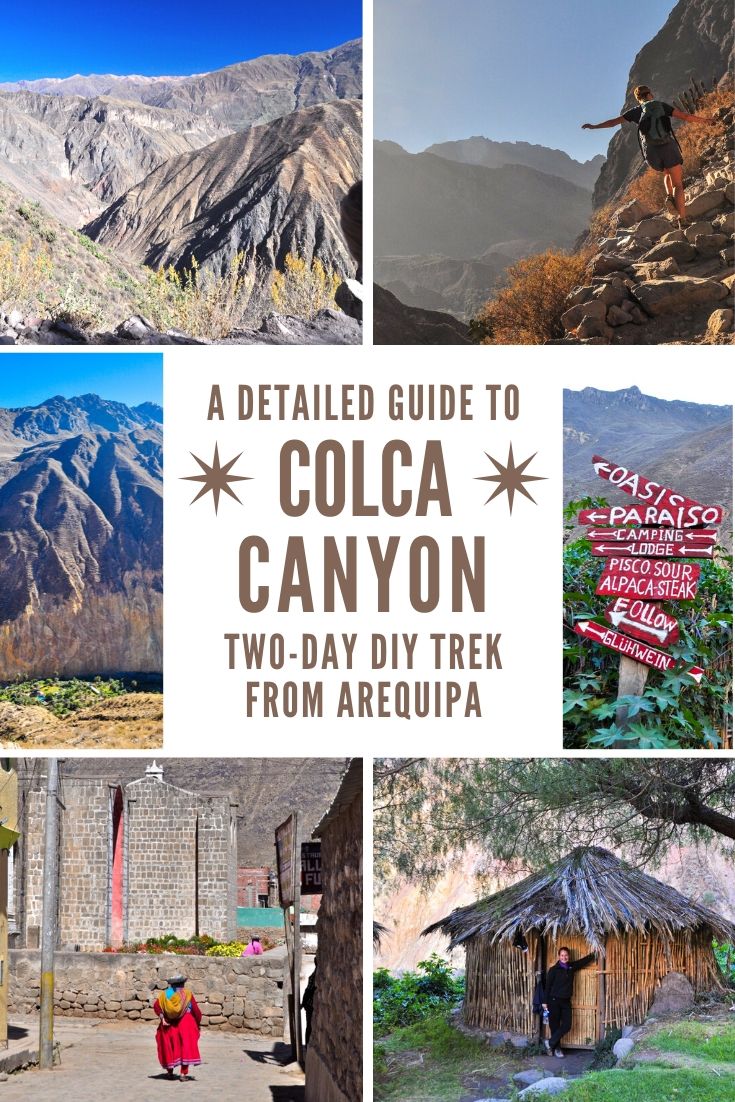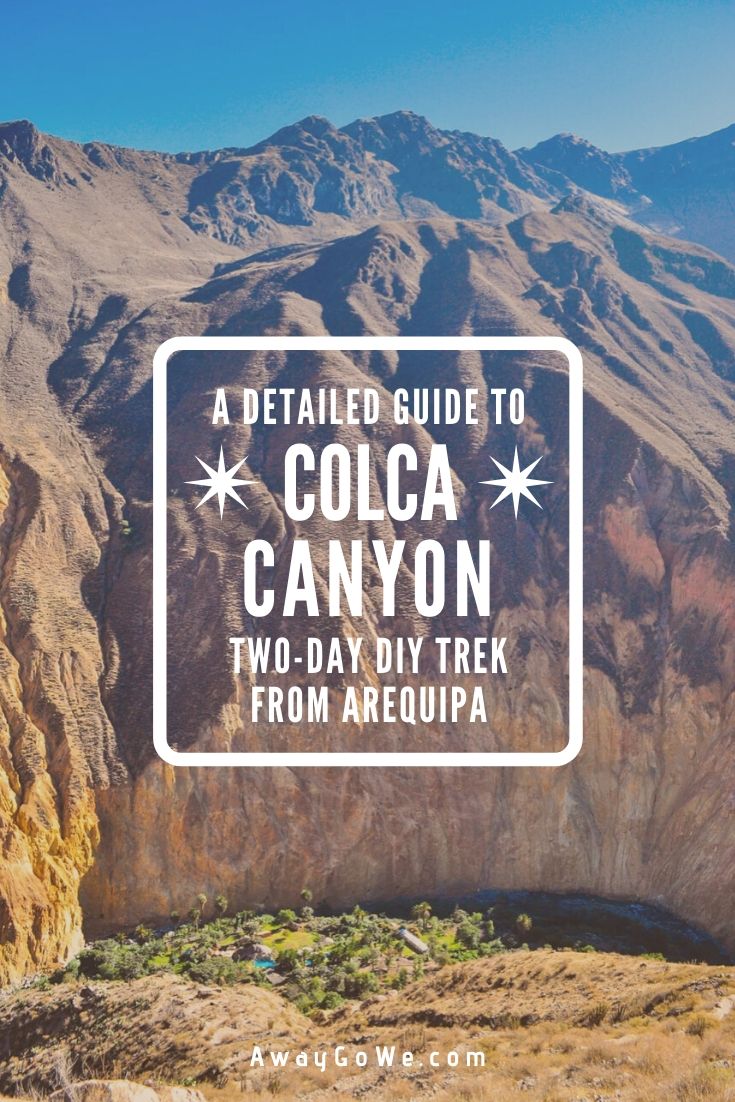Is a Colca Canyon Trek worth it? After all, Peru is packed with epic hikes and multi-trekking opportunities. Why Colca Canyon?
If you’re on the fence about whether to do a Colca Canyon trek (or just need a little bit of inspiration), this article will satisfy your curiosity and help get you on your way.
All of our tips and information are based on our own first-hand experience doing the trek on our own and piecing all of the travel logistics together ourselves.
There are a lot of travel guides out there for putting together a Colca Canyon trek, but few that offer readers an understanding of what the hike to the bottom is like (and the journey to get there from Arequipa).
We offer as detailed a picture as we possibly can based on our experience for those looking to do something similar.
This article is perfect for those wanting to do a similar two day Colca Canyon trek, but we also believe that those looking to explore further afield will find lots of practical and helpful information here as well.
Whether you choose to descend into the depths yourself, or with a guided group, doesn’t really matter in order to appreciate this amazing natural wonder.
A half day’s journey from lovely Arequipa, Colca Canyon is not to be missed if you find yourself in this part of Peru. Here’s why, plus helpful tips for your own Colca Canyon trekking adventure.
This post contains affiliate links. If you click and make a purchase, we might receive a commission (at no added cost to you). Thanks for supporting independent, ad-free blogs!
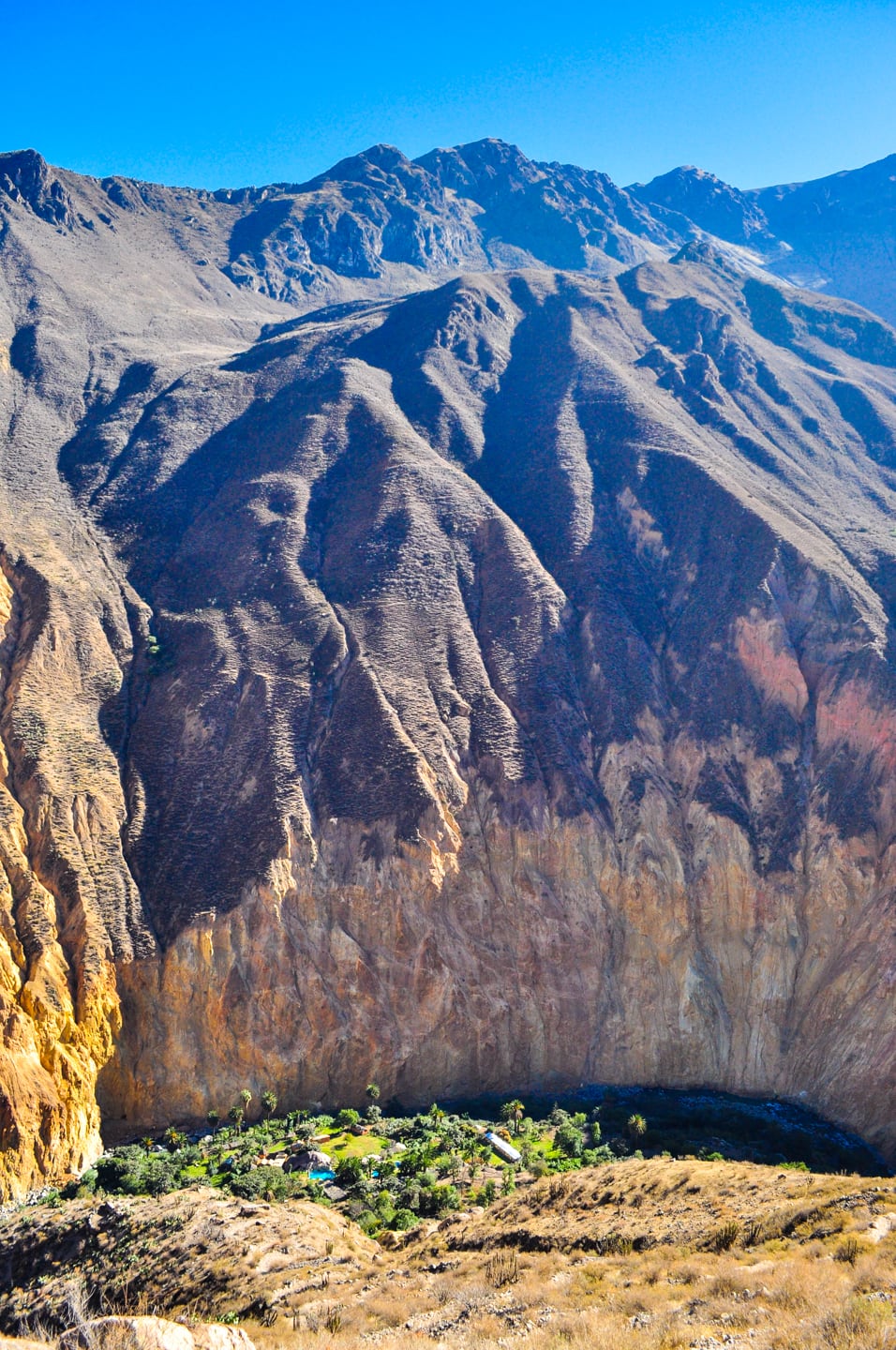
Why Trek Colca Canyon?
Plunging a mind-blowing 3,270 meters (10,730 feet) into the Peruvian Altiplano, Colca Canyon is a supremely spectacular sight to behold.
Lori and I have done a number of multi-day treks across the globe but our Colca Canyon trek tends to stick out in our minds as one of the more unique and stunning ones we’ve done.
We visited the canyon on our week-long overland meander en route from Lima to Cuzco, and the experience was one of the highlights of our time exploring Peru.
Hiking Colca Canyon also has the added benefit of helping you acclimatize and providing a bit of relief to those who need just another day or two at a lower elevation to adjust before pushing on to Cuzco.
Read on to learn more of why we loved our Colca Canyon trek in our detailed trip report.
BUT FIRST, some tips and considerations for planning your own Colca Canyon adventure.
DIY Trek vs. Tour Company
If we were to do it all over in 2021, we’d definitely book a package trip in advance. While we usually prefer to DIY our travels, a two day Colca Canyon trek from Arequipa can be stressful to piece together yourself with a considerable amount of uncertainty.
If you have unlimited time to trek around Colca, by all means do it yourself. After all, it’s part of the adventure!
But if you’re strapped for time (as most trekkers planning a two-day trek probably are), we recommend booking a package trip. Find out more information and book on Viator and Get Your Guide.
Altitude Sickness
The bus ride from Arequipa to Cabanaconde tops out at around 16,000 feet (4,876 m) which is more than enough to give the average unacclimated visitor altitude sickness.
The good news is that you’ll spend less than hour at this elevation. The bad news is that even at 10,000 feet, many travelers still experience symptoms.
Prior to our trip, we were prescribed Acetazolamide by our travel doc to prevent altitude sickness, and both of us were taking it during this portion of our travel in Peru.
We can happily report that we did not experience any issues with the altitude, but can’t positively attribute this to the medication.
Side effects we experienced from Acetzaolamide include prolonged tingling in our feet and hands (both annoying and concerning at times), and increased need to visit the loo. Be forewarned, a six hour bus ride is not at all conducive to the latter.
Make sure you consult your physician before taking any prescription meds for altitude sickness.
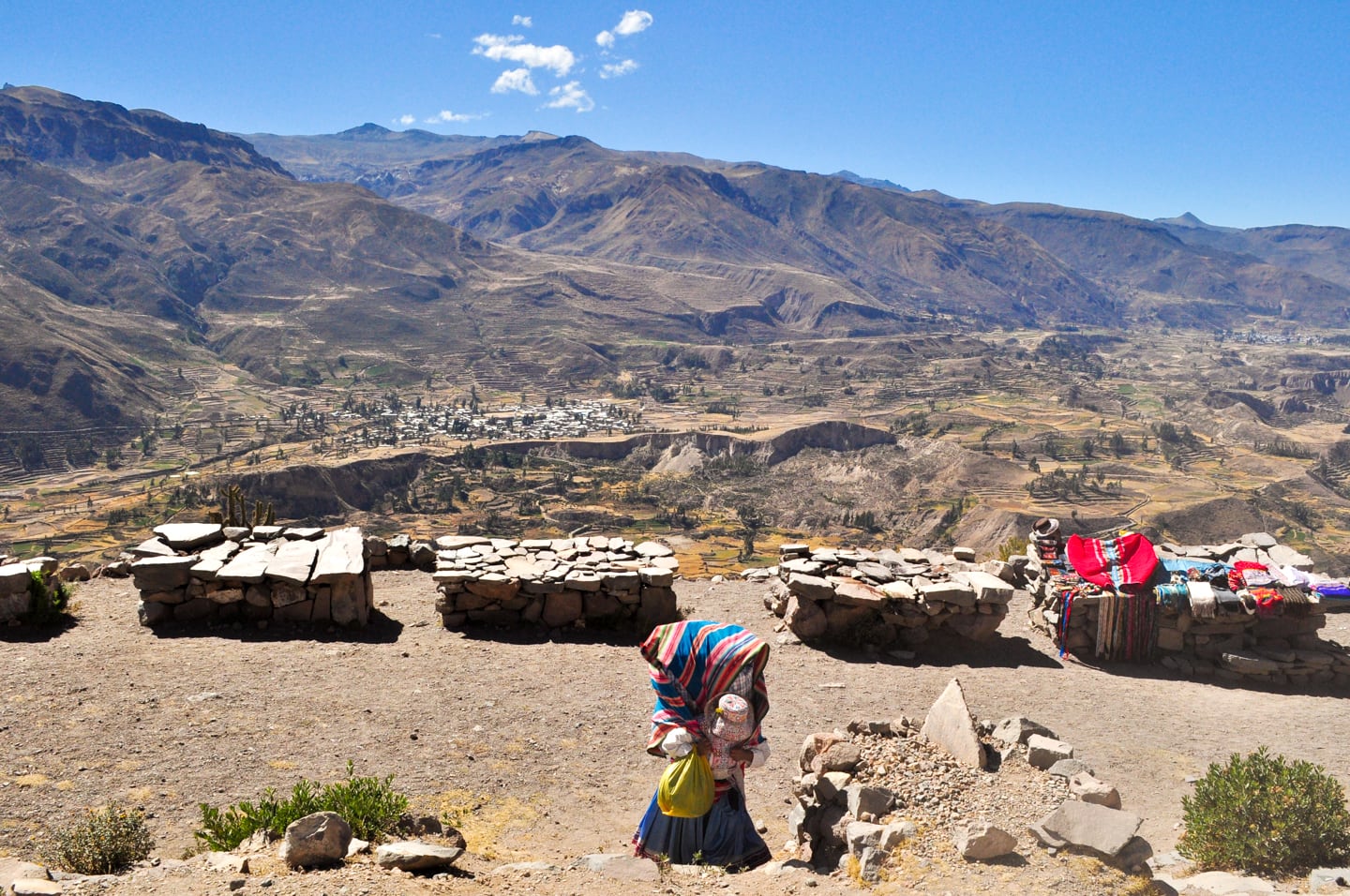
What to Pack
For your Colca Canyon trek, you’ll want to pack a few essentials and maybe bring along some optional gear as well. Beyond the essentials, our best advice is keep it light! What goes down must come up!
Your top priorities on the Colca Canyon trek are going to be keeping yourself hydrated and protecting yourself from the brutal, high elevation sun, particularly while making the arduous hike down (and back up) then canyon wall.
With that in mind, 30+ SPF sunscreen and some sort of head protection (like a sun hat) are recommended. A neck cover (shemagh) is also a great idea.
With regards to hydration, we recommend bringing along a lightweight hydration backpack, particularly if you plan on doing multiple treks in Peru (e.g. the Inca Trail), but of course a reusable water bottle will suffice as well.
Make sure you wear a sturdy pair of hiking boots or shoes for your Colca Canyon trek.
While it is feasible to do the hike in hiking sandals or tennis shoes, you’ll have lots of opportunities for ankle rolling and slip-sliding on the descent down, and you’re going to want as much traction and support that your footwear can offer.
For this reason, you may want to also consider bringing telescopic trekking poles, which would also come in handy on the Inca Trail and other hikes.
Bringing along a compact first-aid kit is also recommended as there isn’t much in terms of health care out here and parts of the canyon can be pretty remote.
If you plan on venturing beyond Sangalle, you’ll definitely want to make sure you are well-equipped for the remote and rugged environment.
A compact, water-resistant headlamp is a good idea if you plan on doing a one or two-day hike, as the sun sets much earlier in the depths of the canyon.
Other odds and ends you’ll definitely want to have with you is money (you’ll want to withdraw the total amount you’ll need in Arequipa before getting on the bus), and a bathing suit and pack towel (most of the lodging options at the bottom of the canyon (Sangalle) have swimming pools.
Of course, don’t forget a good camera for capturing your adventure and this amazing place.
Lastly, don’t forget to bring along flexibility and a sense of adventure! In Peru, things don’t always go according to plan. Nowhere is this more true than in rural and remote areas of the country. Expect the unexpected and enjoy the experience!
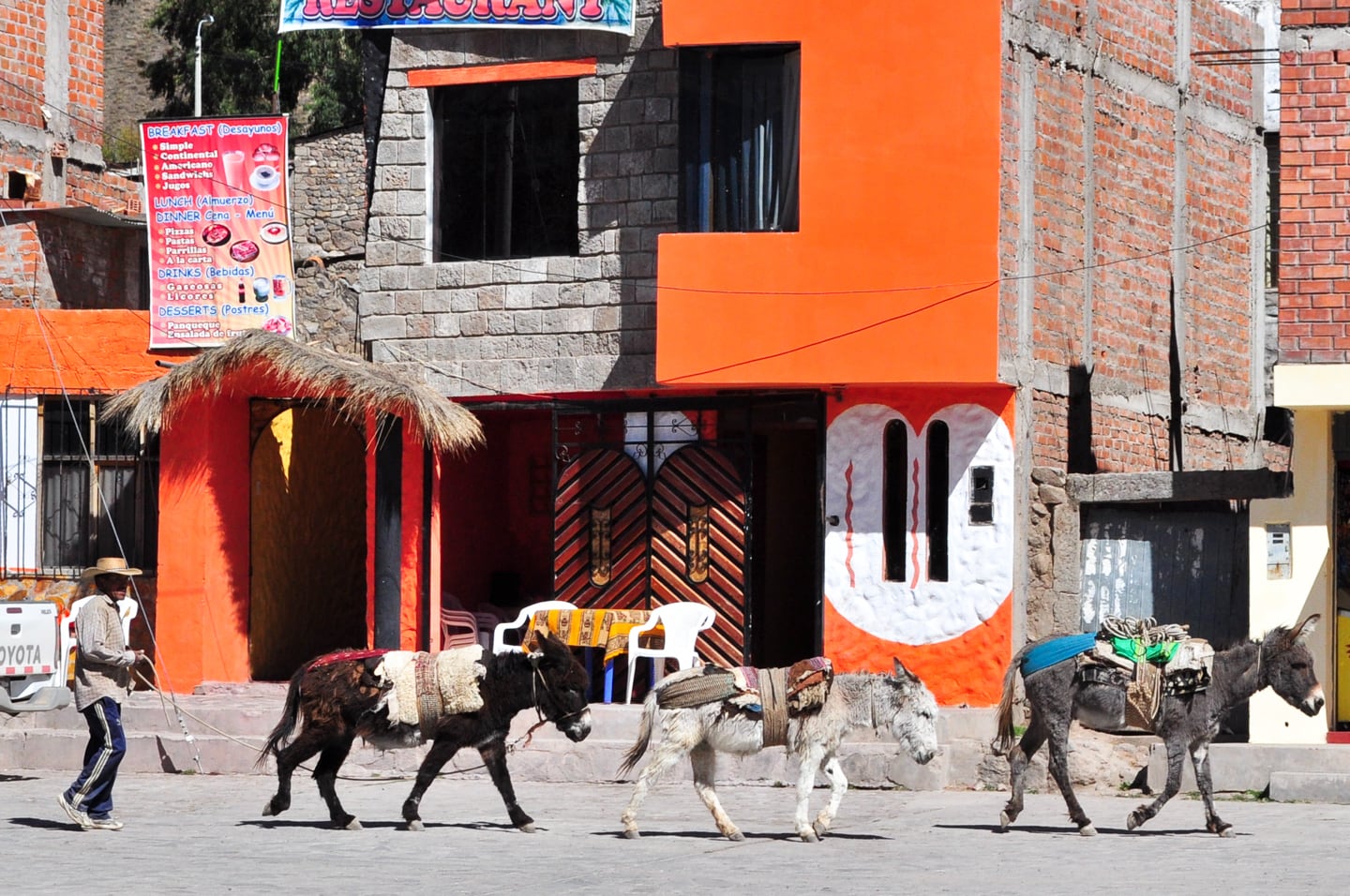
Other Tips & Considerations for Your Colca Canyon Trek
Nightfall in the Canyon Comes Early
Though tempting, don’t linger too long in Cabanaconde on Day 1. Night falls quickly due to the depth of the canyon and its wise to leave plenty of time the unexpected.
Travelers Prone to Motion Sickness & Fear of Heights
If you’re prone to motion sickness, arrive early at the bus station to secure a window seat close to the front of the bus. Much of the route is fairly curvy.
If you’re afraid of heights, you may want to forego the window seat. But then again, you may want to rethink this trek!
Extend Your Trekking Time
If you have time and flexibility in your schedule, do yourself a favor and double or even triple the amount of time earmarked for trekking Colca Canyon (and even stay a night or two in Cabanaconde, itself).
While we feel two days was sufficient for squeezing in a trek from Arequipa to the bottom of Colca Canyon and back again, that’s really the tip of the iceberg in terms of what there is to see in and around this amazing canyon.
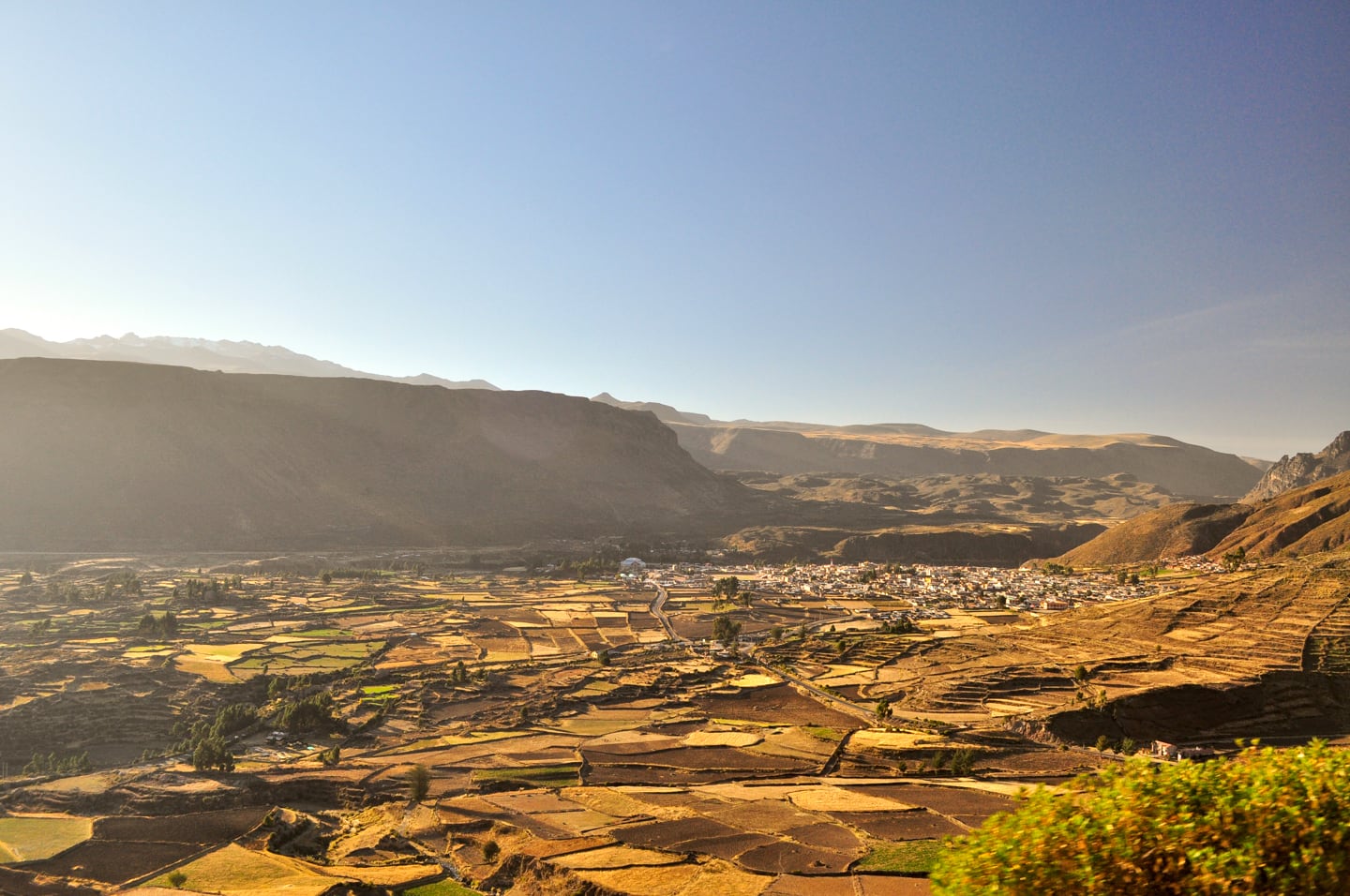
Getting to Colca Canyon from Arequipa
For a while, we maintained a fairly detailed guide to getting between Colca Canyon and Arequipa, doing our best to keep it as up to date as possible. But, as you’ll undoubtedly find yourself, transport options and timetables change frequently in Peru.
We decided to remove the timetable specifics and all that jazz, but have left in the tips that we think will still serve you well.
If you’re curious about the buses and routes we took, that’s still included in our detailed trip report below.
We opted for a two-day, DIY Colca Canyon Trek. You may very well find that rushed (we did). But if you’re strapped for time, the trip is indeed manageable in this amount of time and can be fairly straightforward to put together yourself.
- The most convenient (and thus most popular) jumping off point for Colca Canyon is the wondrous White City of Arequipa. With direct flights and daily overnight buses from Lima, as well as its UNESCO world heritage status, you should definitely consider spending a few days here before or after your Colca Canyon trek.
- The classic two-day Colca Canyon trek starts in Cabanaconde, a pleasant village perched on the cliffs of the canyon. Cabanaconde strikes a rare balance between traditional and touristic, and is certainly worth a wander around (or overnight stay) if you have time.
- Daily public buses to Cabanaconde depart early from Arequipa and the journey typically takes around six hours.
- Expect a sunrise departure from Arequipa on day one, and a dusk return to Arequipa on day two, owing to daily afternoon bus departures from Cabanaconde.
- If you opt for a private shuttle or tour package, your journey may be longer or shorter depending on the number of tourist site stops en route.
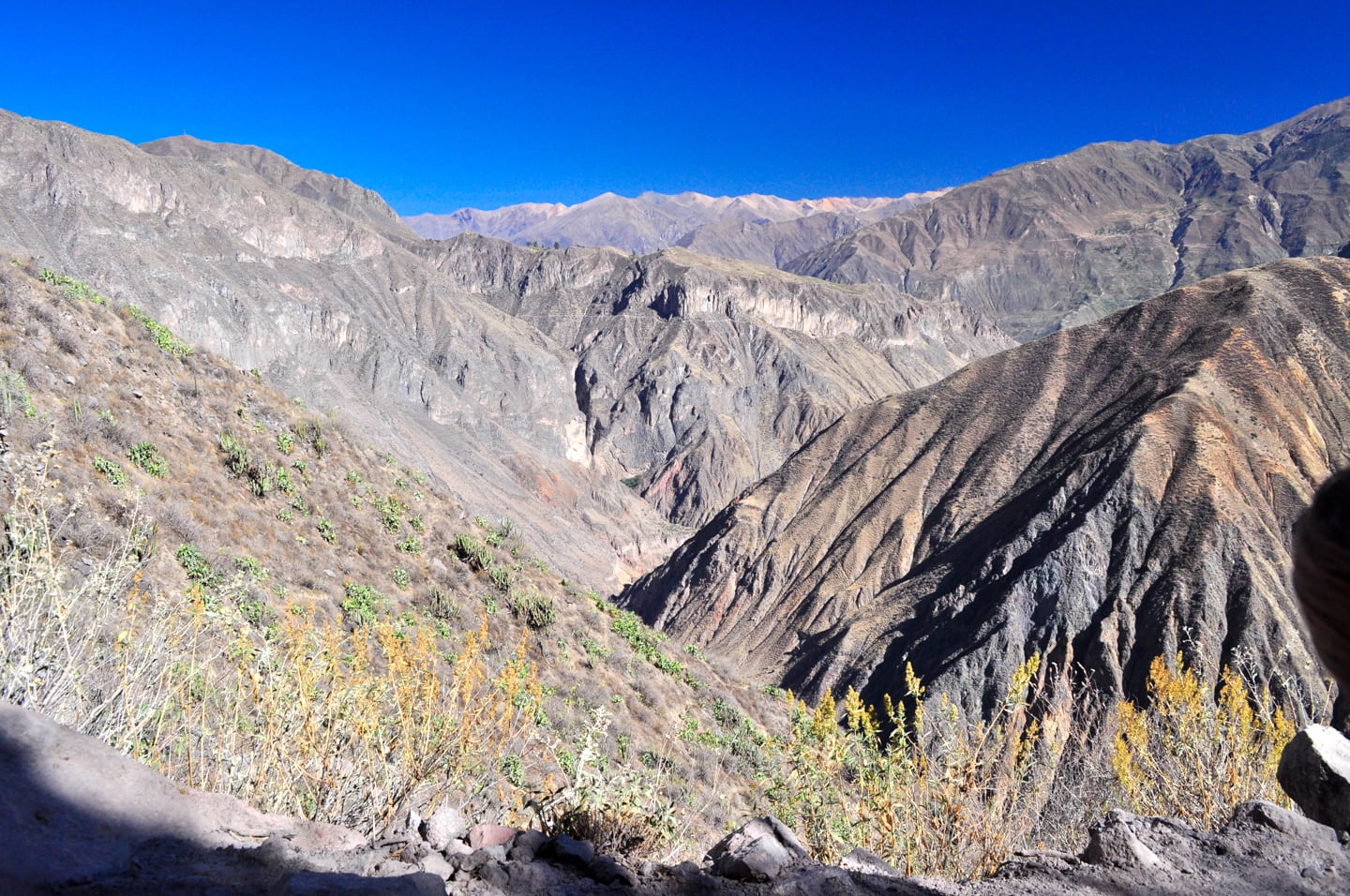
Our Trip Report: Colca Canyon Trek in 2 Days
Part One — Bus Journey from Arequipa to Cabanaconde
Lori and I arrived at the bus station in Arequipa at 5am to buy our tickets, stock up on snacks for the journey, and grab our seats.
We were pleasantly surprised to find our bus was mostly loaded with locals, as well as a few other travelers. We noticed that many of the local people were wearing traditional attire — large, flowing skirts and embroidered tops and hats (fishing hat or top hat style).
Our transport for the day was one of the Andalucia Bus line’s beat-up workhorses with big, off-road tires — a bus that had certainly seen better days but no less seemed up to the journey.
We grew to respect this bus and all it had undoubtedly gone through over the years, and the bus driver who obviously had nerves of steel and knew his stuff.
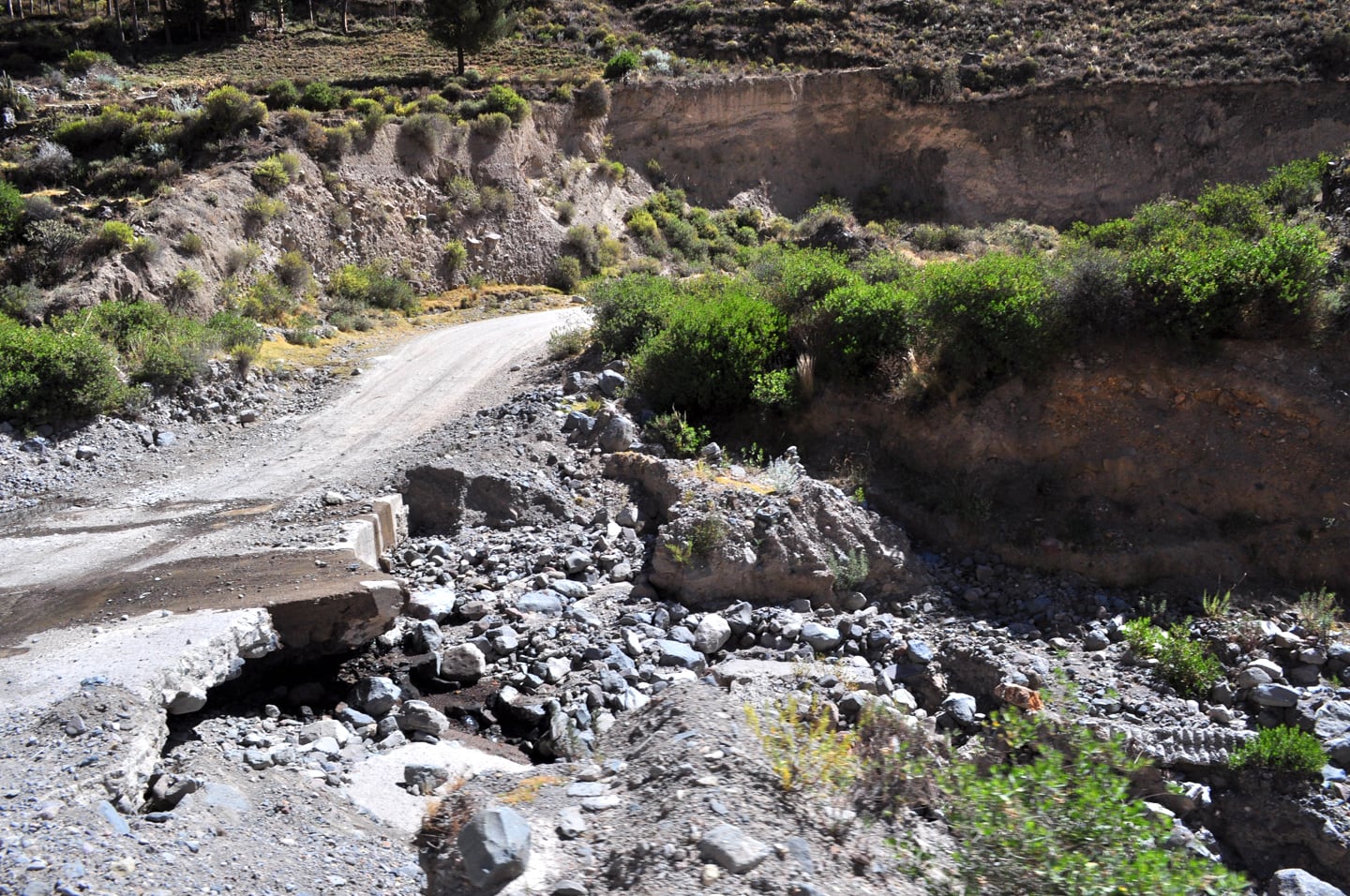
Before long, we left the pavement behind and started gaining altitude on curvy, unsealed roads. I was surprised that Lori managed to sleep through a 16,000-foot pass, a few stops, and many, many sharp turns.
The Altiplano has a starkly beautiful quality to it. But at around 15,000 feet I began to feel the effects of the high elevation for the first time (while Lori slept like a baby).
Fortunately, it didn’t take long before the route began to descend again, dropping 4,000 feet down into Chivay in a matter of about 15 minutes.
The road into Chivay was winding, yet paved, and when we finally reached Chivay I felt a broad sense of relief knowing that the next time I would see that road, we would be ascending slowly.
Little did I know what lay ahead…
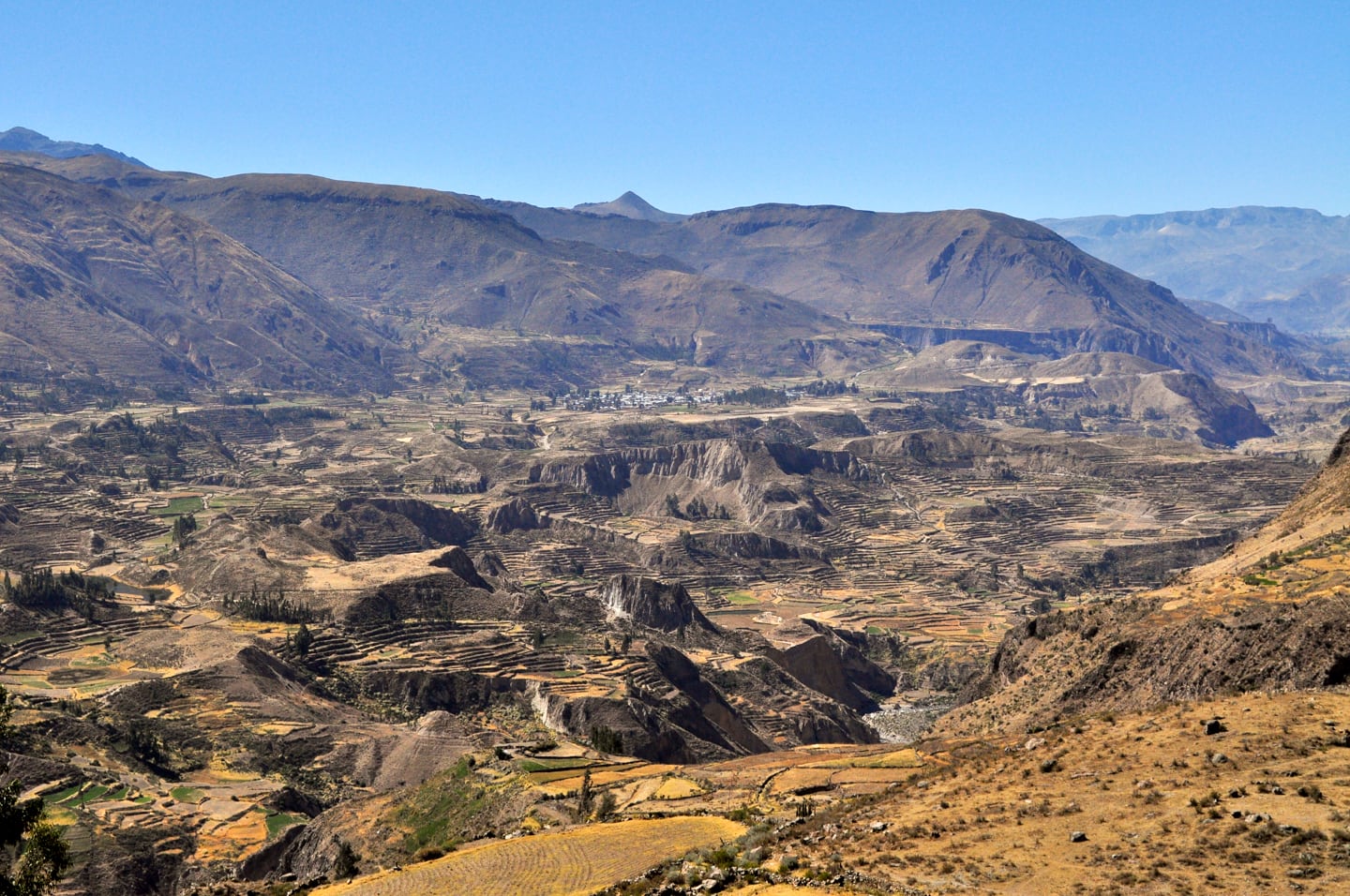
After Chivay, we quickly left the pavement again (permanently this time) and embarked on three white-knuckled hours of hugging the edge of the high canyon walls.
We raced along the winding and narrow (single lane) dirt road, through small towns and long crude one-way tunnels at a sobering pace.
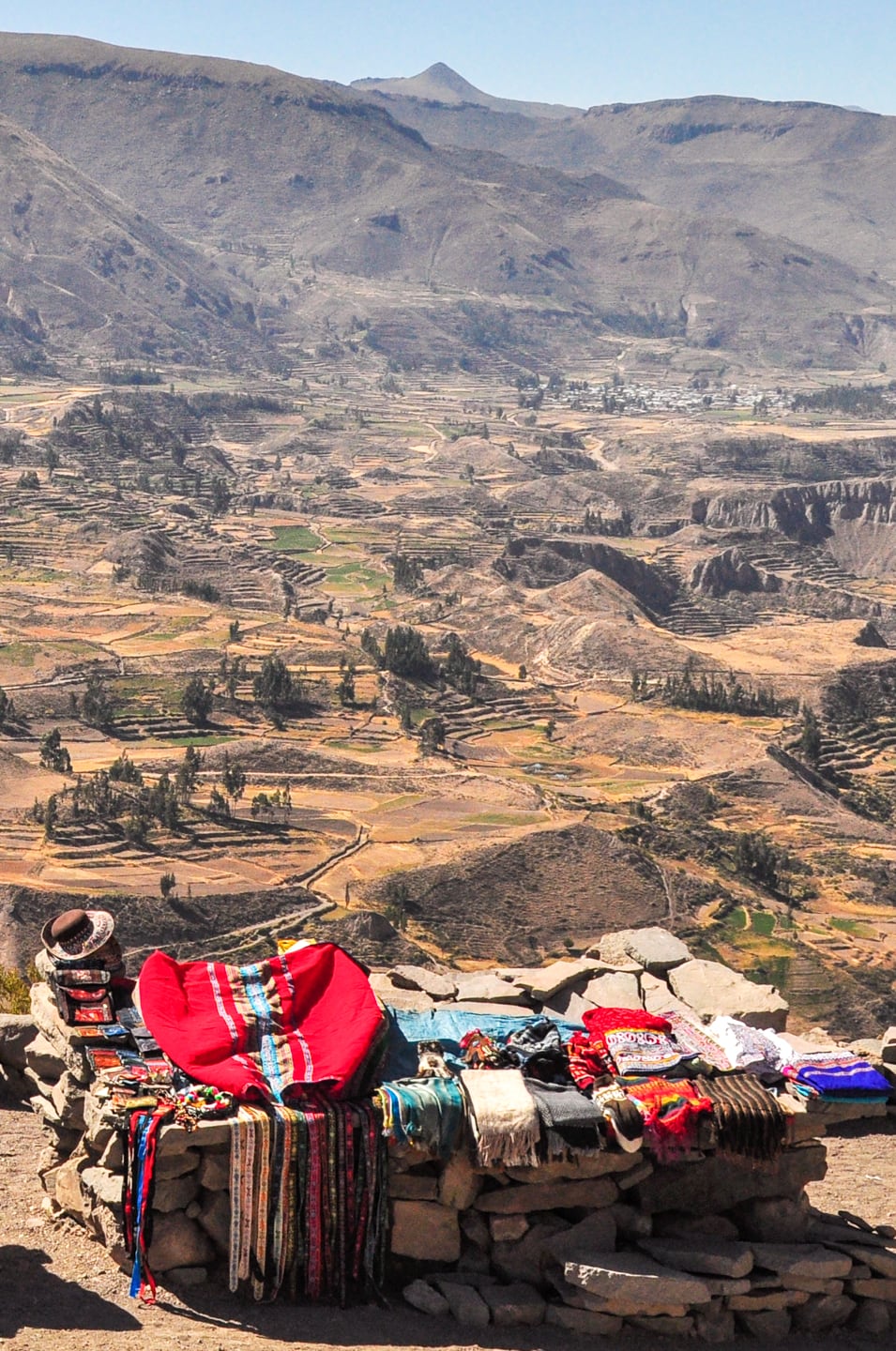
Souvenirs laid out for tourists against the breathtaking backdrop of “Cruz del Condor.”
The canyon was on the right-side of the bus where I sat, and at times I would stick my head out of the window only to see a 5,000-foot sheer drop.
Every curve was essentially a “dead man’s curve,” adorned with shrines in memory of less fortunate travelers who had once passed this same way.
It was great fun riding with the locals as locals do, and in retrospect I can certainly say it was a most enjoyable adventure (knowing now that I lived through it).
After a long, yet satisfying, six hours we made it to dusty Cabanaconde (about 11,000 feet elevation), the small village where our Colca Canyon trek begins.
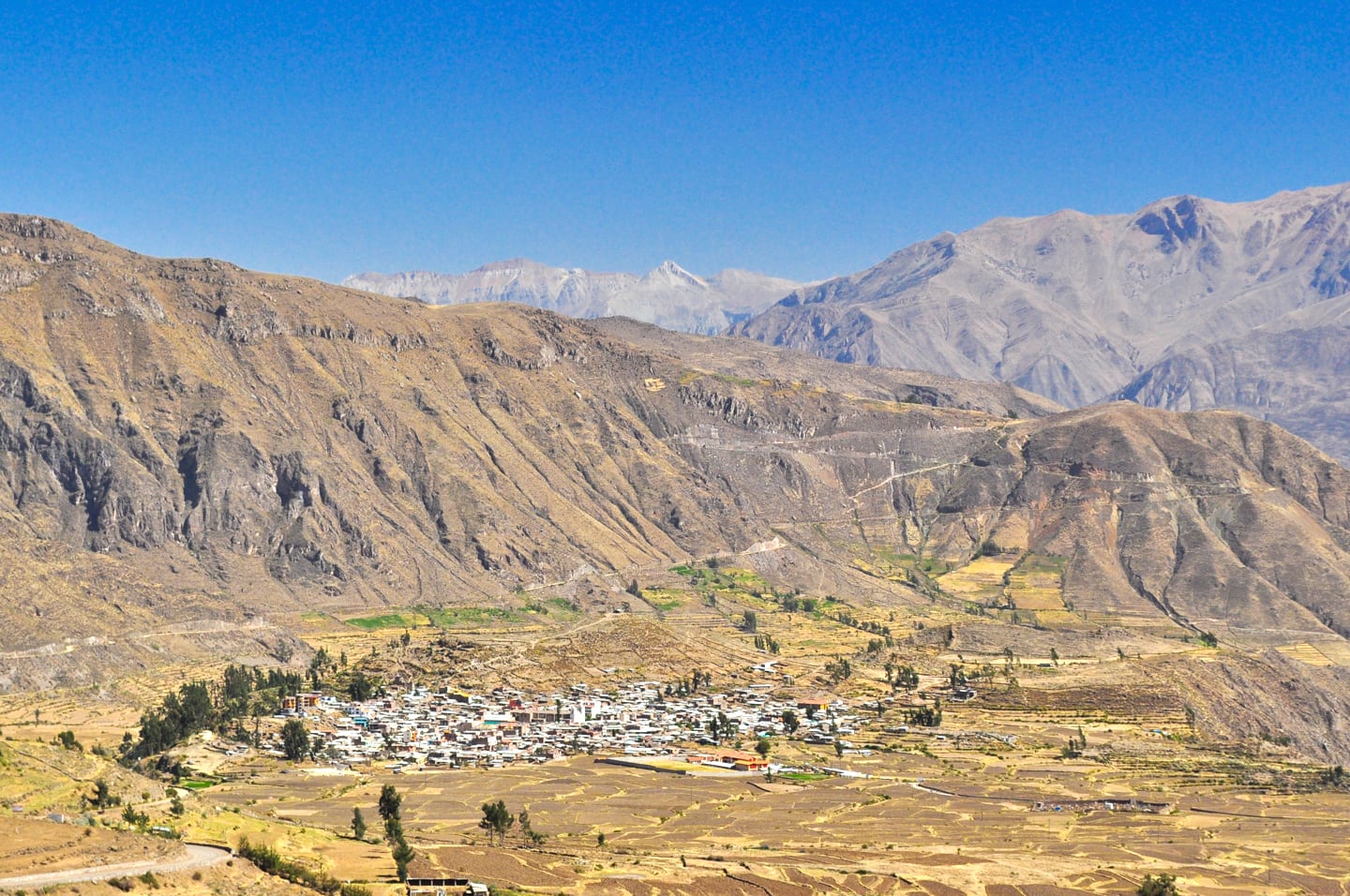
Our bus arrived in Cabanaconde around noon, giving us the afternoon to grab a bite to eat in town and descend into Sangalle, the lush oasis at the bottom of the canyon where there are a few excellent options for overnighting.
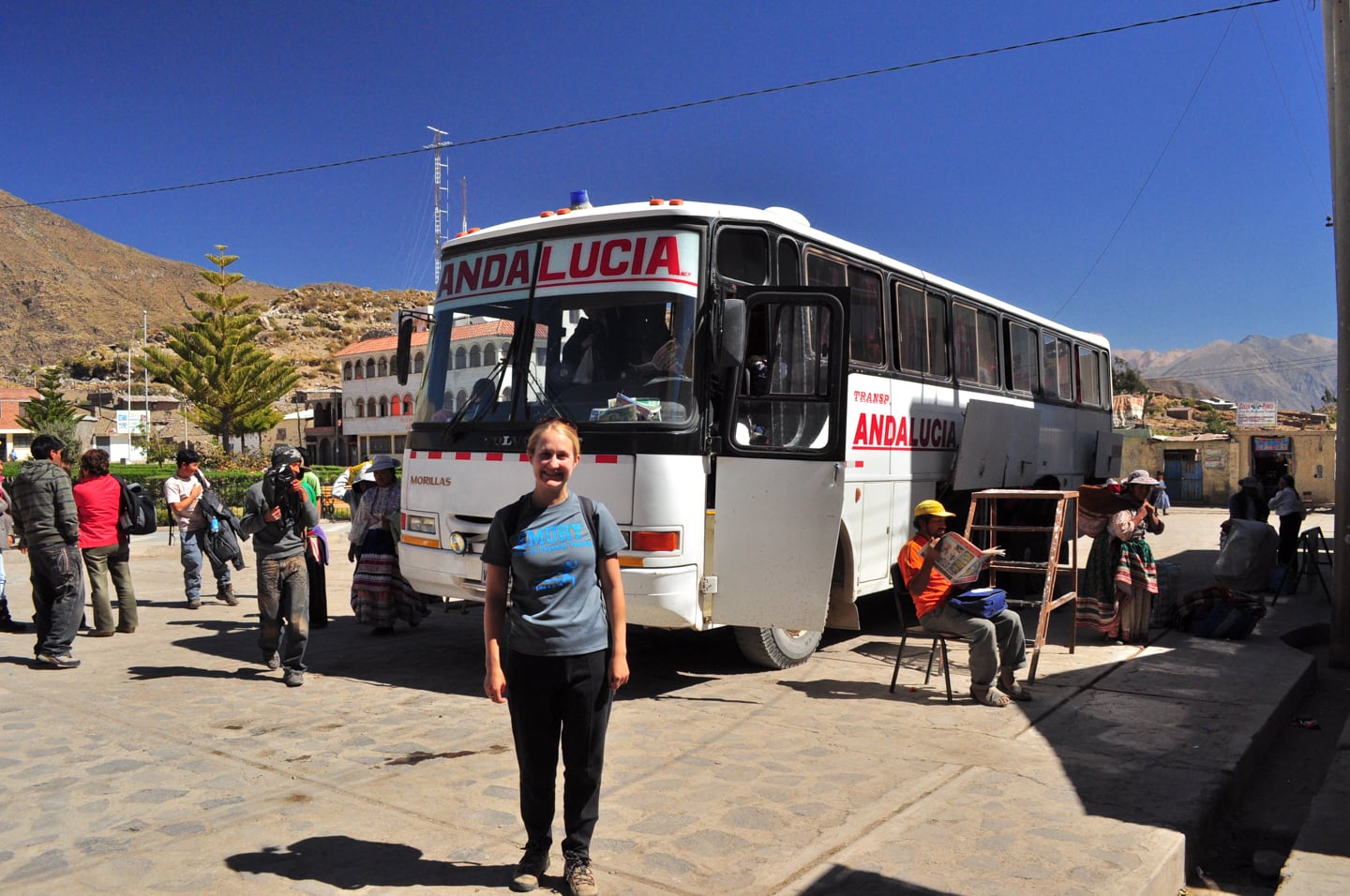
Lori, standing proudly in front of the Andalucia bus (which incidentally looks much nicer in the photo than in person) and all of the hubbub surrounding its twice-daily arrival.
We decided to refuel at a small hostel; Lori enjoyed lomo saltado con arroz (like carne asada, but on rice, not a tortilla) with mate de coca (tea with coca leaves…good for altitude sickness, so they say).
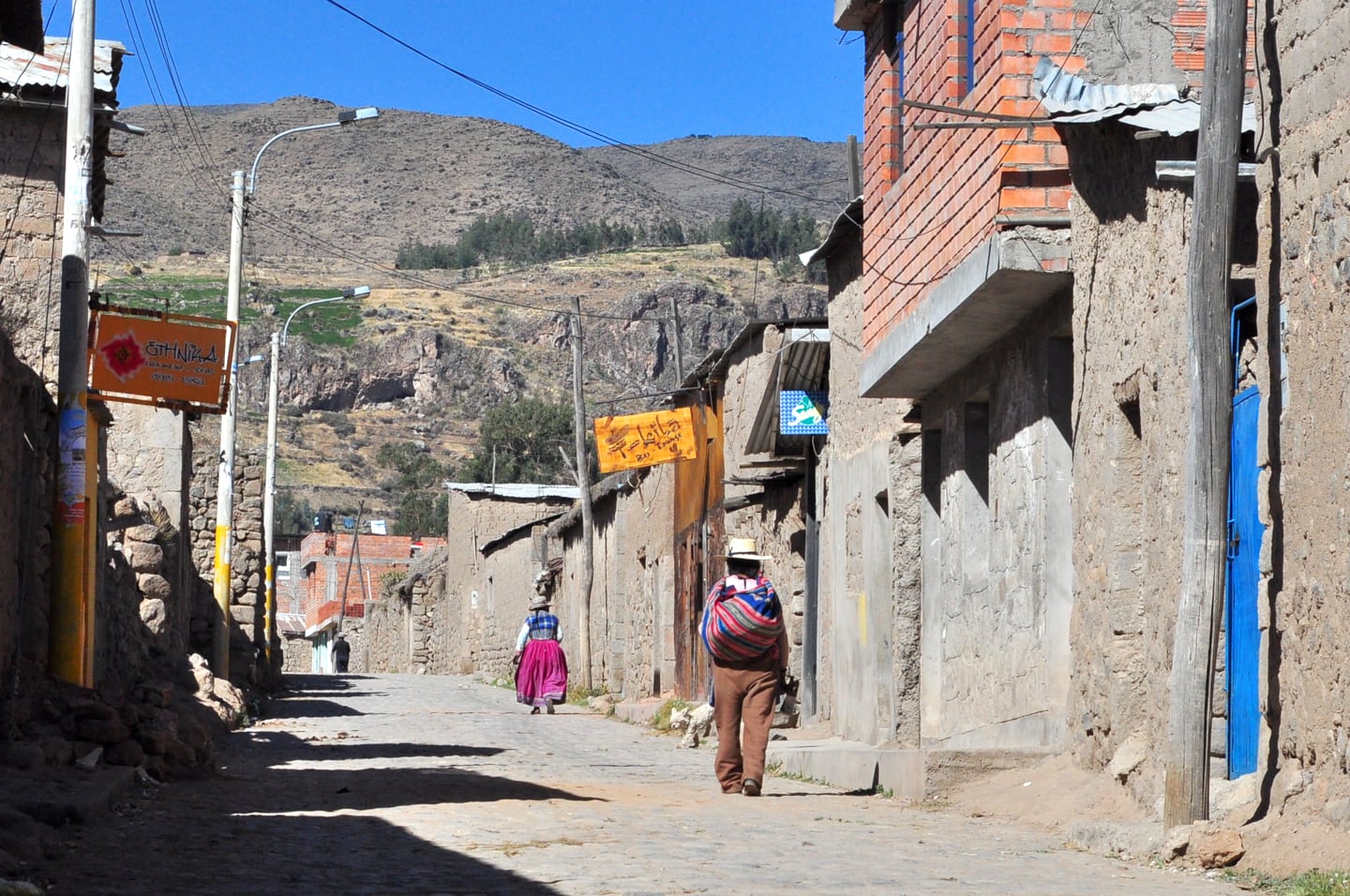
After lunch, we both felt quite full, but recharged and ready to hit the trail. Following some helpful advice from a French guy at Hostal Valle del Fuego we begin our Colca Canyon trek.
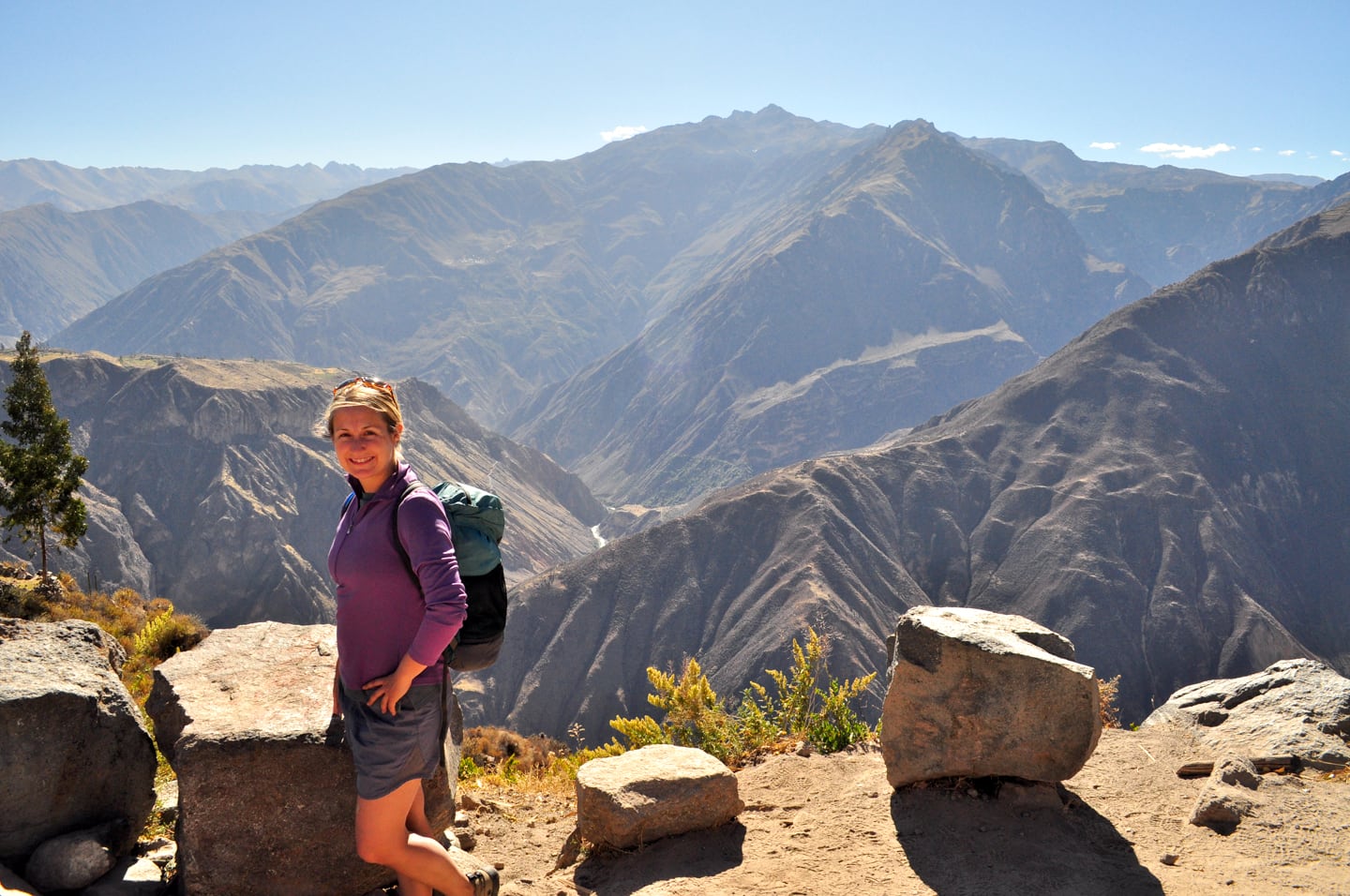
Part Two, Our Colca Canyon Trek Begins! — Hiking from Cabanaconde (10,784 ft.) to Sangalle (7,087 ft.)
Just about now, I know what some of you are thinking — Colca Canyon is 10,730 feet (3,270 m) deep. So that means that we’ll be descending…how far…!?
Fortunately, the starting point for the trek, Cabanaconde, is already a good portion of the way down the canyon (we aren’t starting anywhere near the highest point).
Still, from Cabanaconde to Sangalle at the bottom of the canyon, hikers descend 3,698 vertical feet (1,127 meters), which is nothing to sneeze at.
And don’t worry. On the Colca Canyon trek, what goes down certainly must come back up.
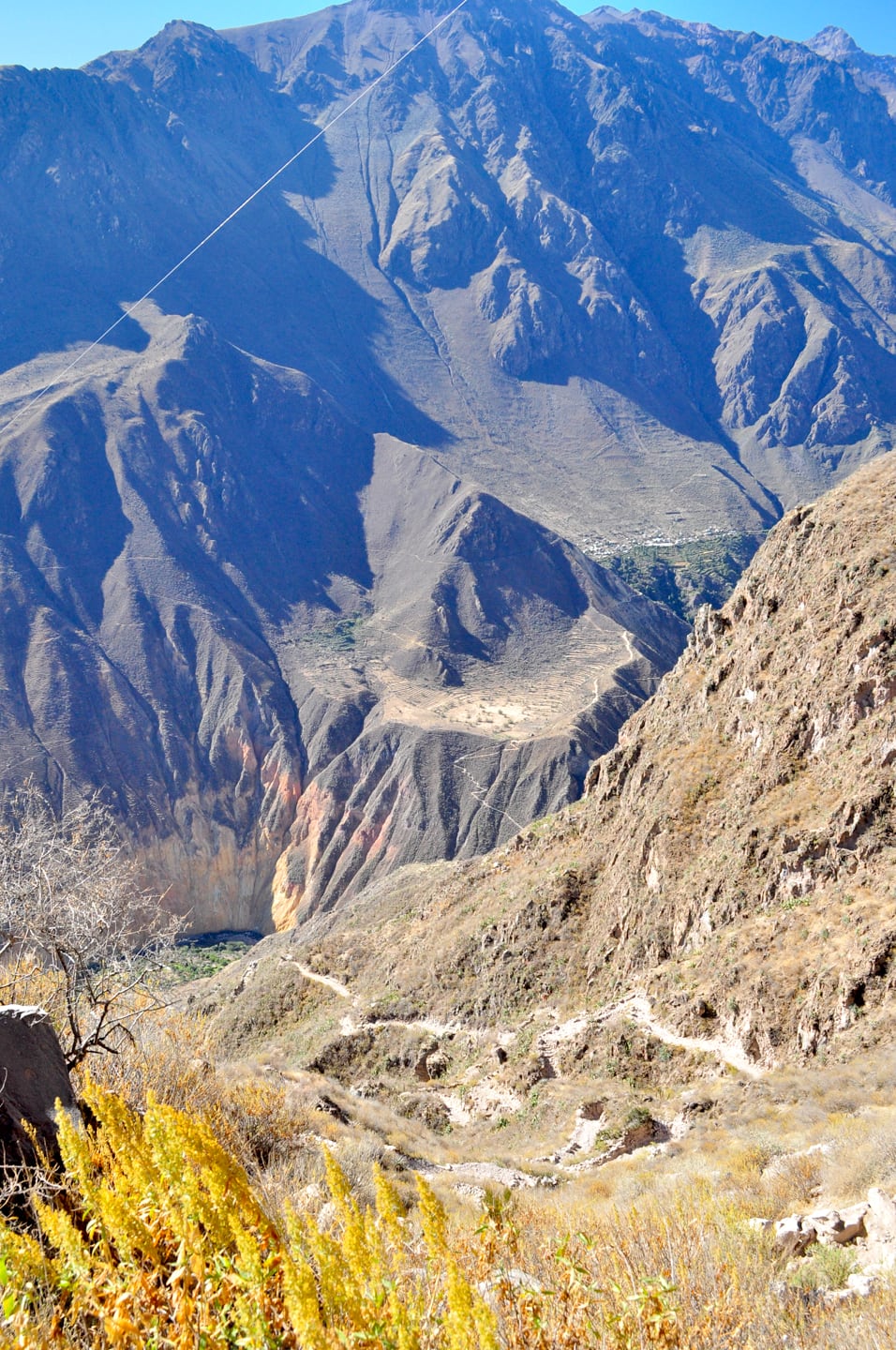
It took us about 2.5 hours to make the steep, rocky descent to Sangalle (el Oasis) at the bottom of the world’s second deepest canyon. Not too shabby.
Although not aerobically demanding, the hike down did do a number on our toes and quads.
The views were awesome and we stopped to see the many trails and villages clinging to the canyon’s walls.
We didn’t take a lot of pictures on the way down mostly due to being in a hurry to get off the trail before sunset. But we more than made up for it on the way back up the next day.
🔥 HOT TIP 🔥
Be aware, that the sun sets considerably earlier in the canyon than the official sunset time. For this reason, if you’re doing the two day Colca Canyon trek, you’ll definitely want to bring a headlamp.
Even with a headlamp, however, we strongly advise trying to get off the trail and into Sangalle before nightfall. The trail is rugged, uneven, and can be treacherous even in broad daylight.

Part Three — Sangalle Lodging: Oasis Paraiso Ecolodge
By the time we made it to the bottom the sun was no longer shining in Sangalle even though it was only 16:30, due to the steepness of the canyon walls and doing our hike around the Southern Winter Solstice.
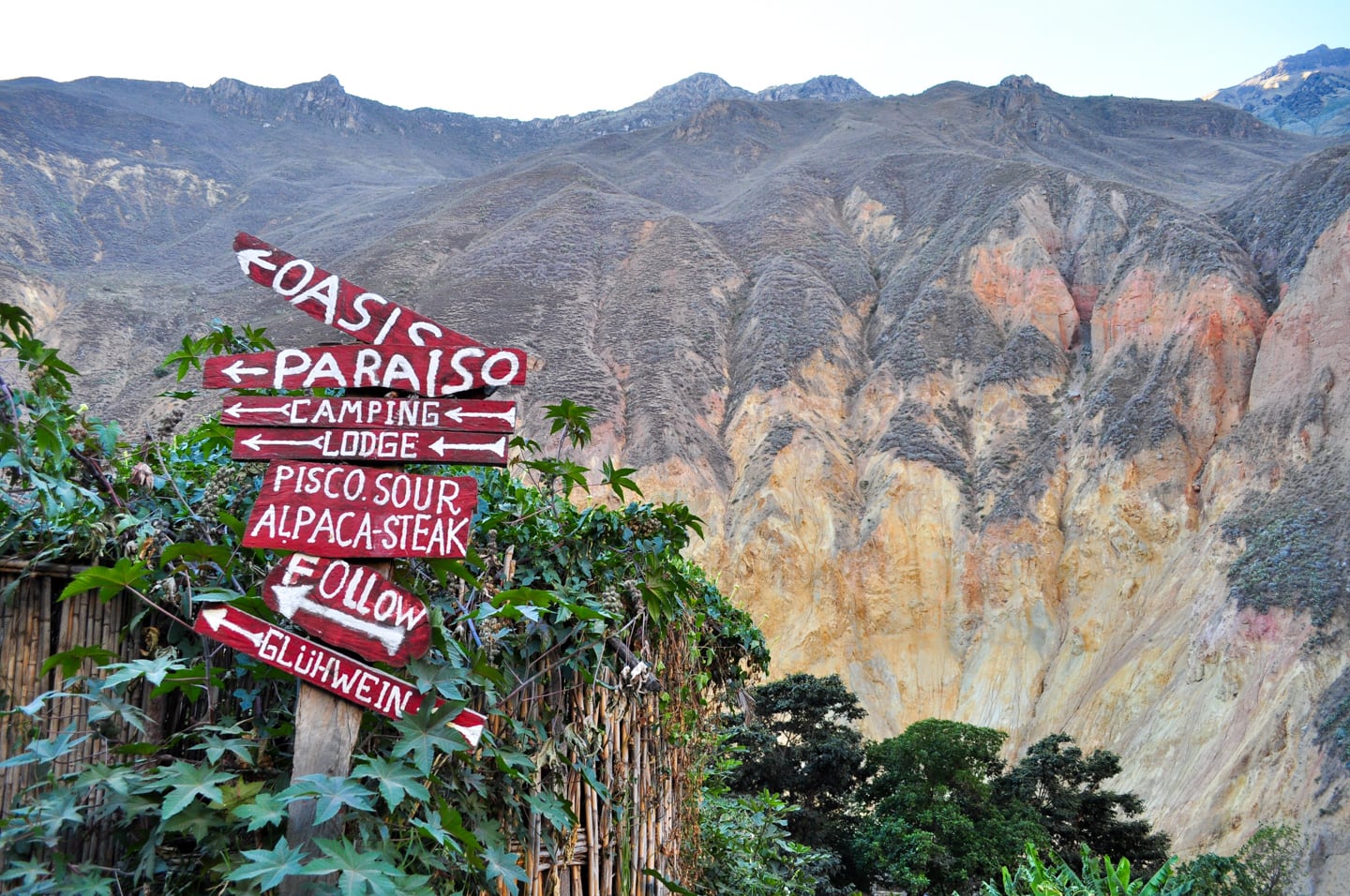
We planned to overnight in Sangalle at Oasis Paraiso Ecolodge, which was highly recommended to us by other travelers and didn’t disappoint.
Lori was, however, a bit bummed when we arrived because the whole way down she was looking forward to cooling off in the pool and drying off in the sun…but I still convinced her to take a chilly dip in the solar-heated pool (with two waterfalls), which felt amazing after the hot and dusty hike.
Our accommodation was basic but exactly what we’d hoped for – a little round, dirt-floor hut made out of reeds for 10 soles (a little over $3 USD) per person.
A dinner of vegetable soup (they are really big on soups in Peru), rice, lentils, and more mate de coca set us back an additional 10 soles for the two of us.
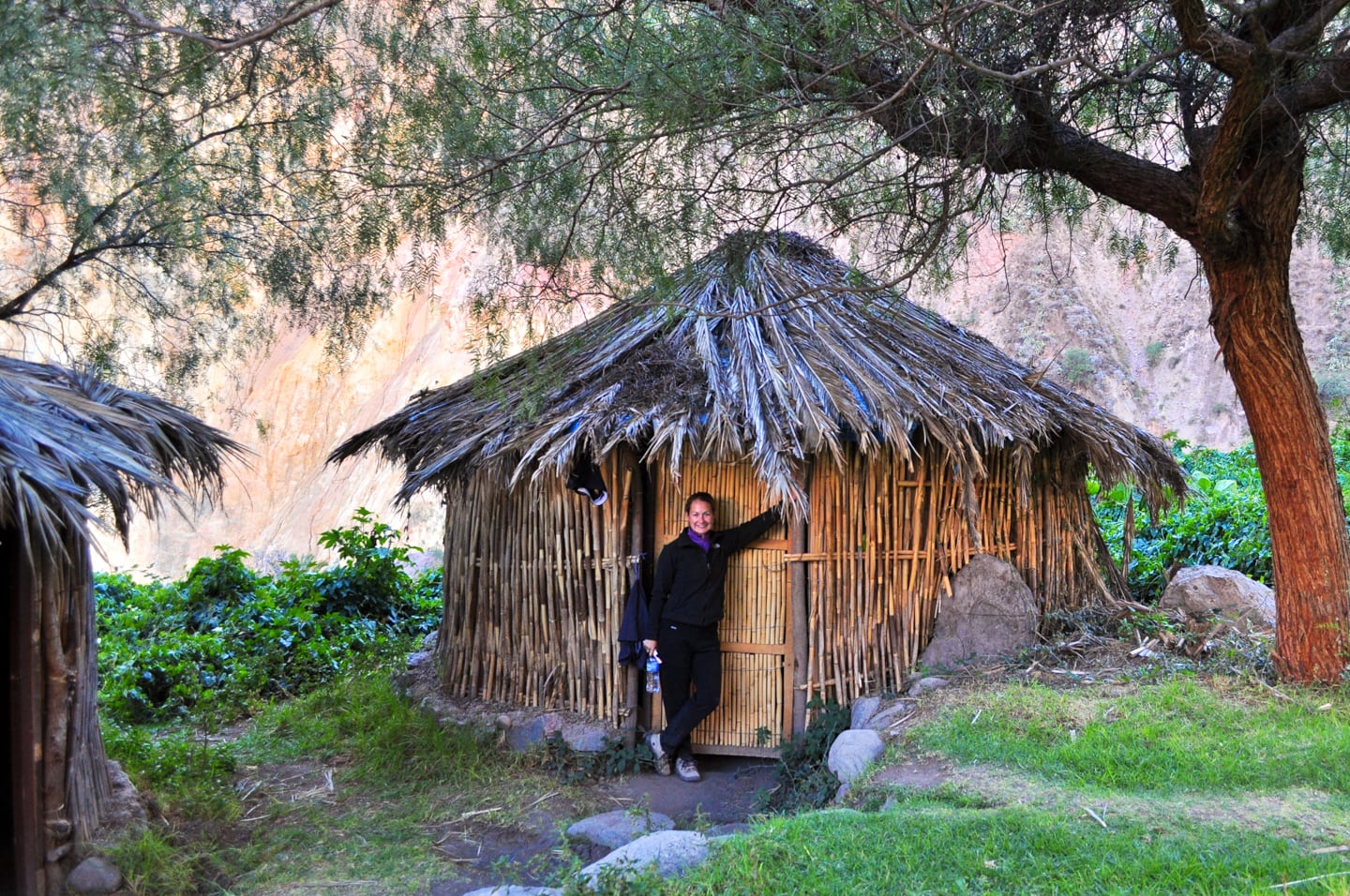
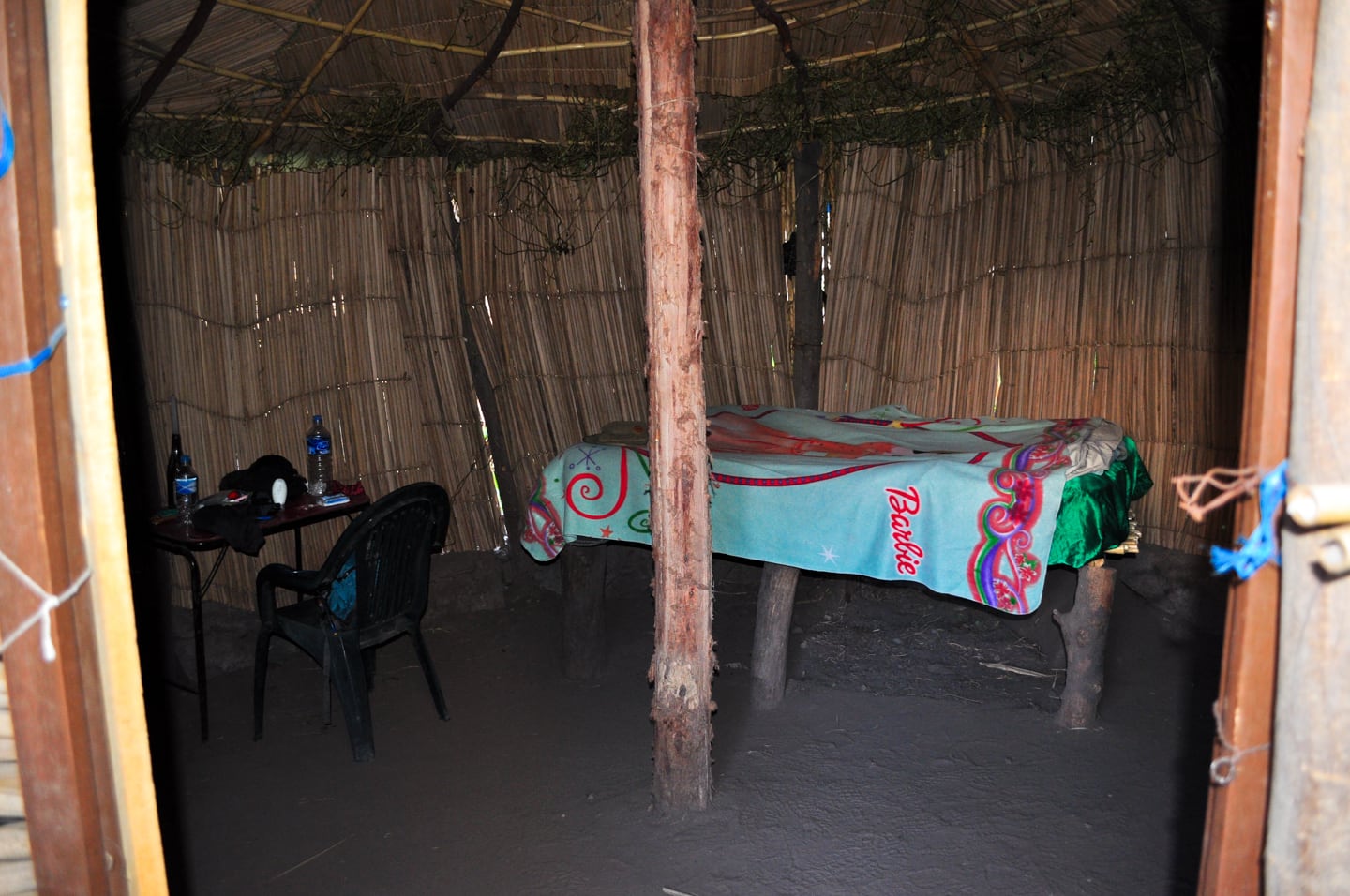
2024 Update
We’re happy to report that Oasis Paraiso Ecolodge still appears to be the preferred overnight lodging option in Sangalle for travelers doing the Colca Canyon trek.
It also appears that Oasis Paraiso have upgraded their accommodations significantly since our visit, while keeping their rates squarely in the budget category.
Oasis Paraiso is still the place we recommend to family and friends planning their own Colca Canyon trek.
That night, we met two brothers from Utah and celebrated 4th of July under the Southern Cross. Lori and I shared a large bottle of Arequipeña to mark the occasion.
While there were no fireworks, there was a shooting star and lots of other very, very bright stars. Easily one of the best 4th’s we’ve spent anywhere.
After a super restful 11 hours of sleep (guess we had some catching up to do!) we packed up, scarfed down an energy bars, and began the long and arduous trek out of the world’s second deepest canyon.
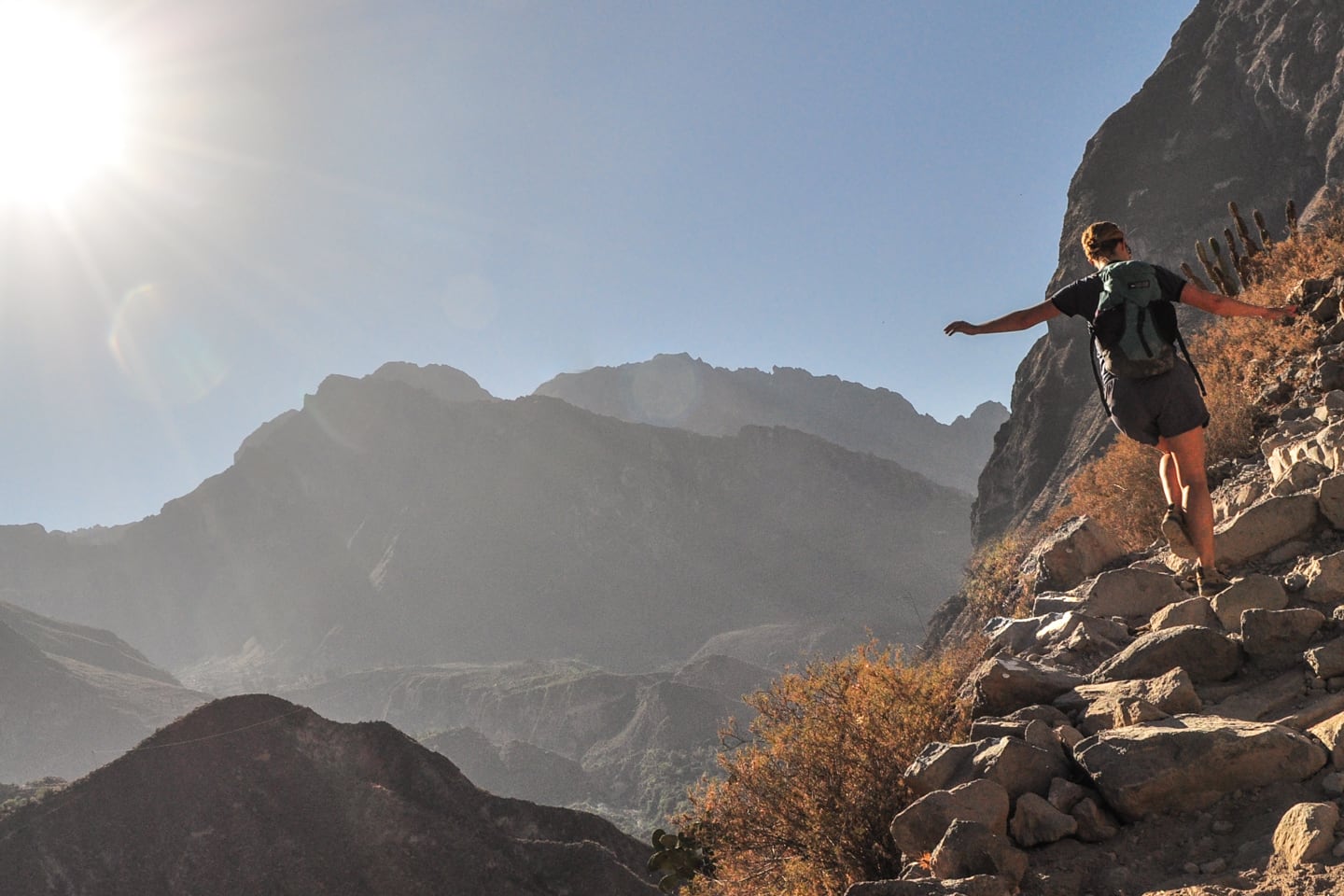
Part Four — Canyon Ascent from Sangalle to Cabanaconde
Climbing out of Colca Canyon is no joke. A combination of high elevation, rough terrain, and constant sun exposure makes for one TOUGH hike.
Our hearts were pounding (Lori says even more than hiking out of the Grand Canyon) and quads burning nonstop.
We stopped frequently to catch our breath and drink water in whatever shade we could find, which became increasingly challenging (if impossible) to find as the morning wore on.
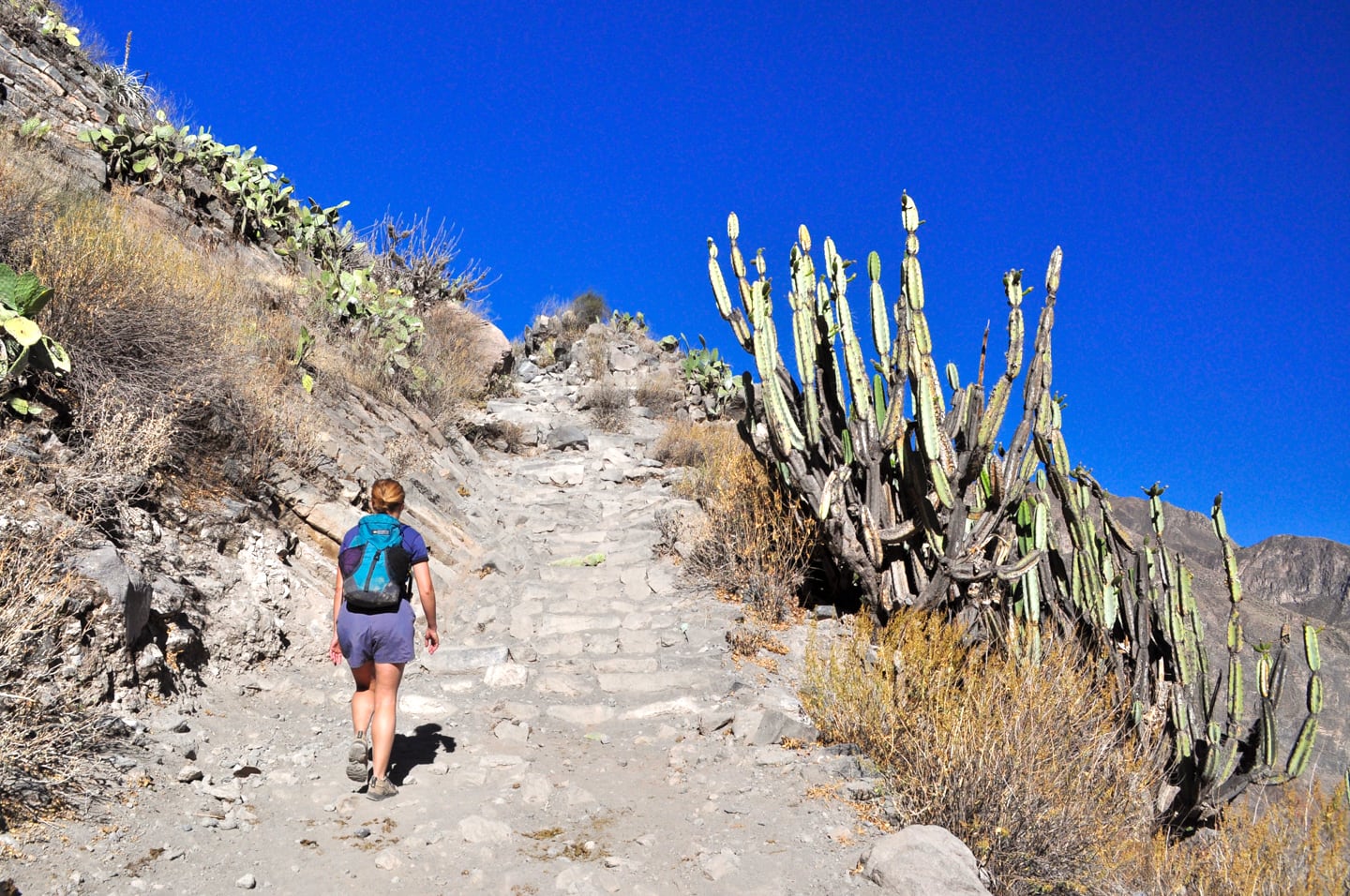
We frequently had to move aside for the dozens of burros (mules) heading down the canyon, and almost got taken out by a couple of them; it was a tight squeeze.
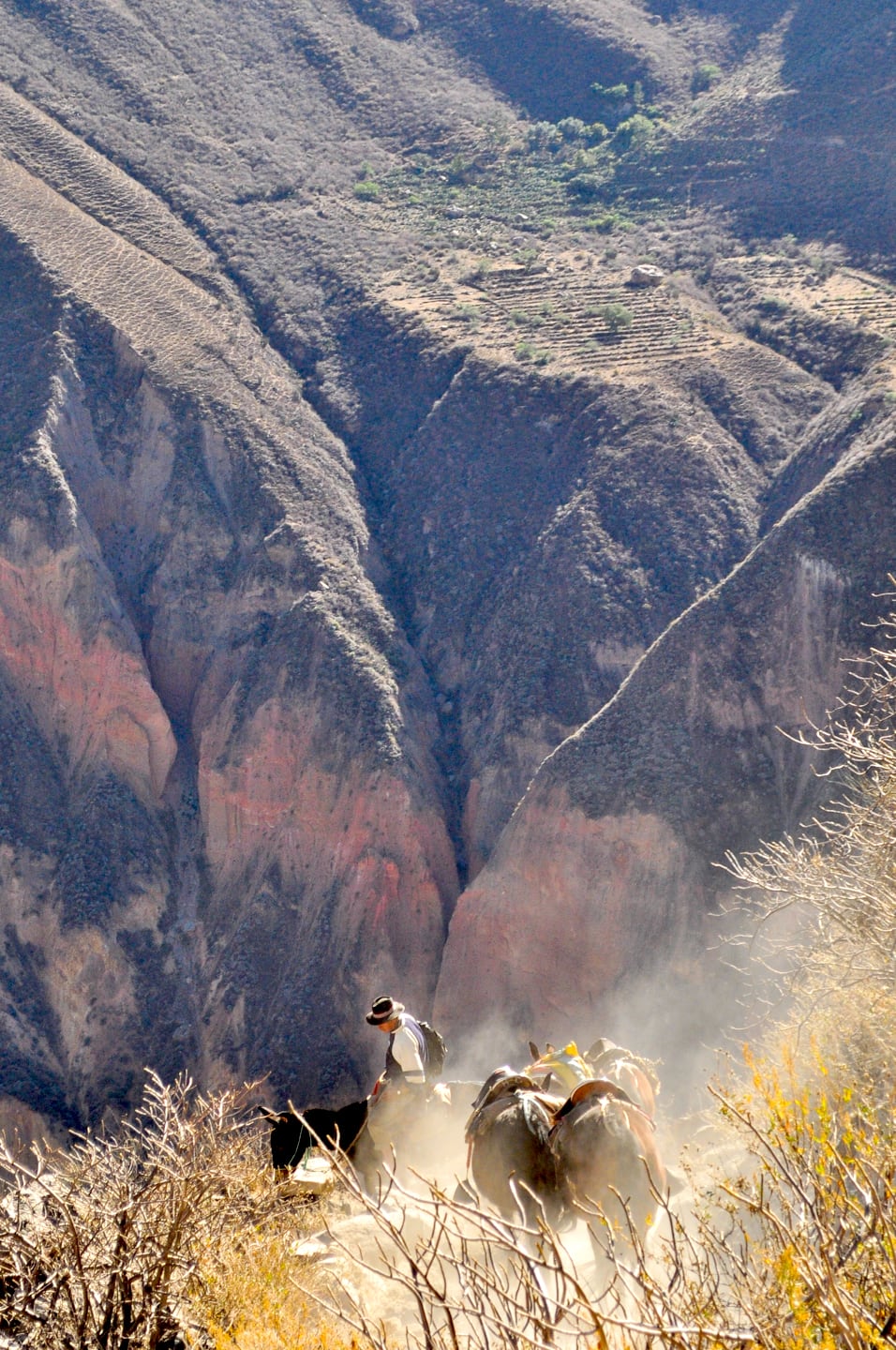
Encountering local residents going about their daily lives along the steep canyon walls was a highlight of our Colca Canyon trek.
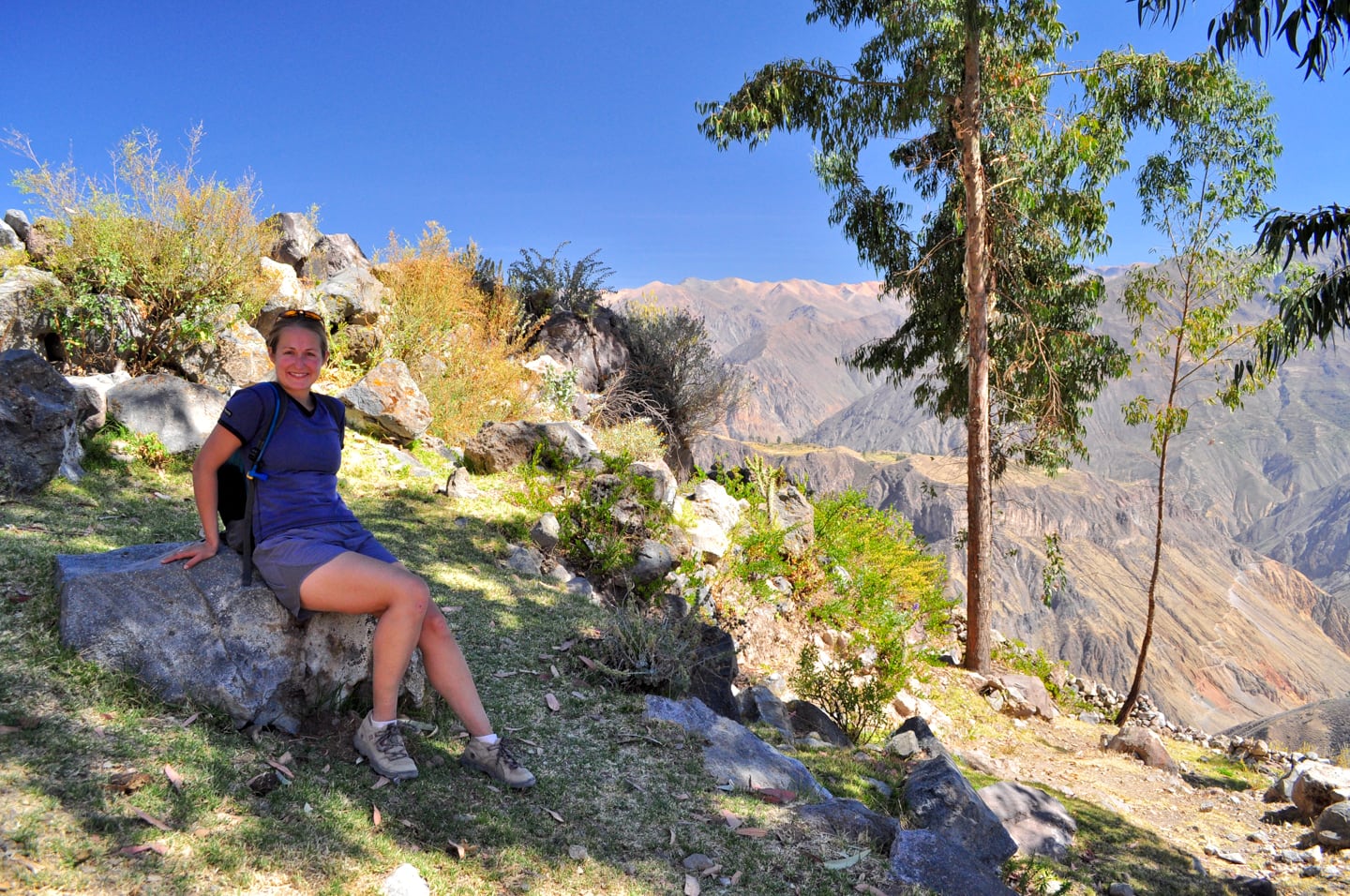
By the time we reached the rim, we were relieved and exhausted. Even with regular stops along the way, our ascent from Sangalle took us just over three hours. It took us another leisurely 15 minutes before we arrived back in Cabanaconde.
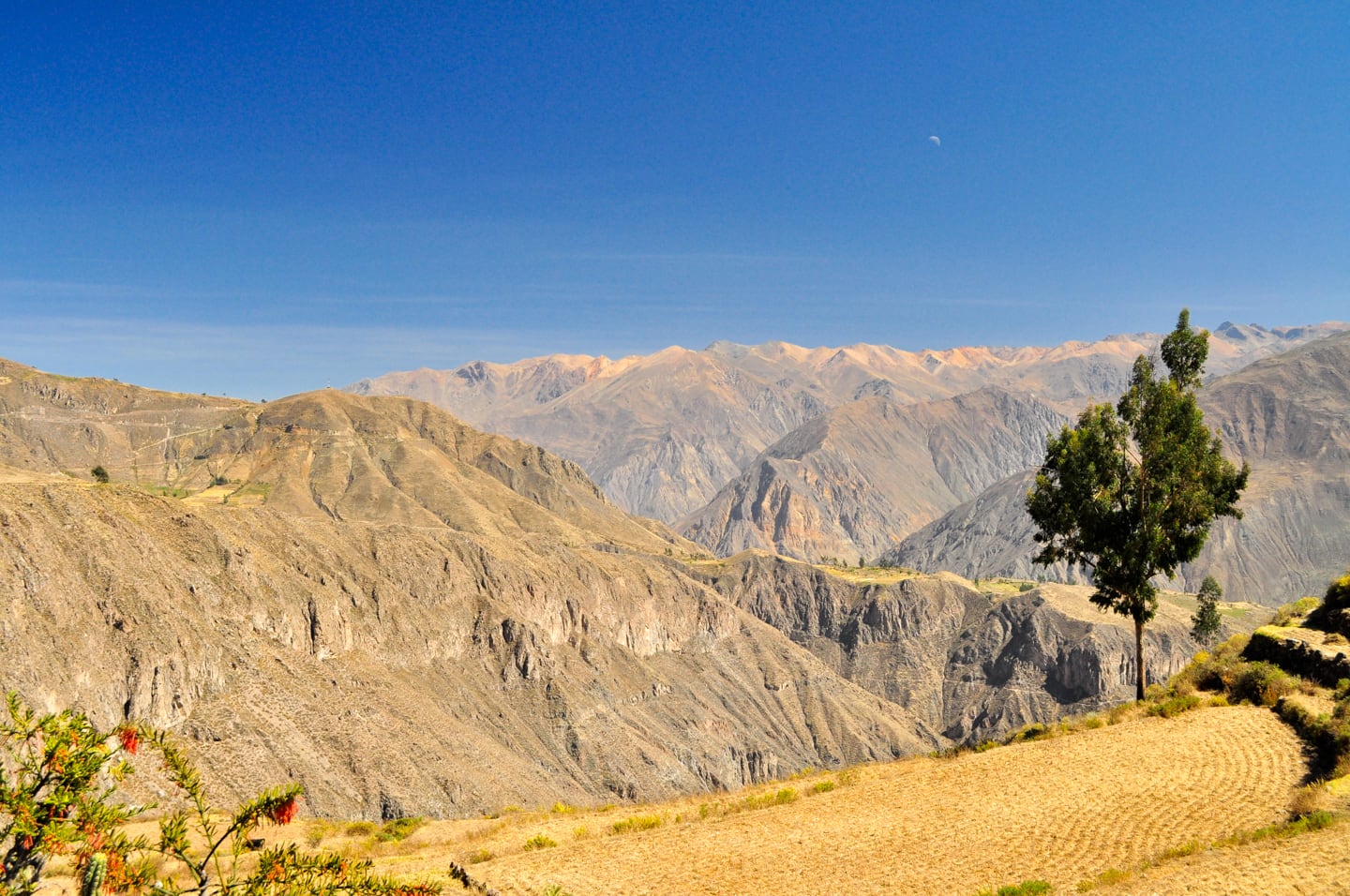
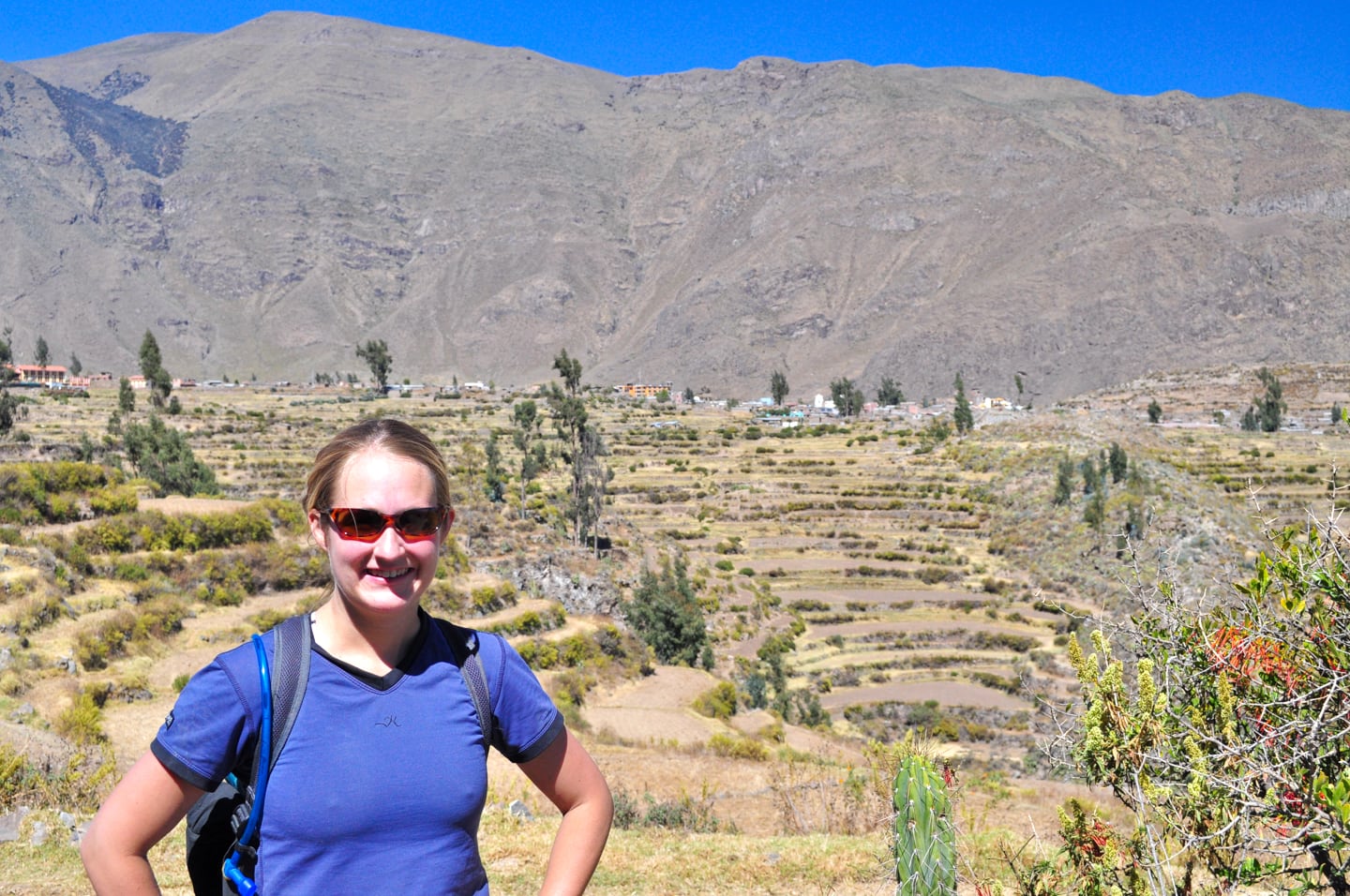
Lori and I treated ourselves to a lunch for 5 soles each (US$1.50) and shared an Inca Kola at a small, family-run restaurant.
We enjoyed watching a stray dog and the proprietor play cat-and-mouse, and listening to a dating-advice-meets-Jerry-Springer show on TV until a small child came marching in angrily from another room to turn it off (apparently disgusted by the poor reception).
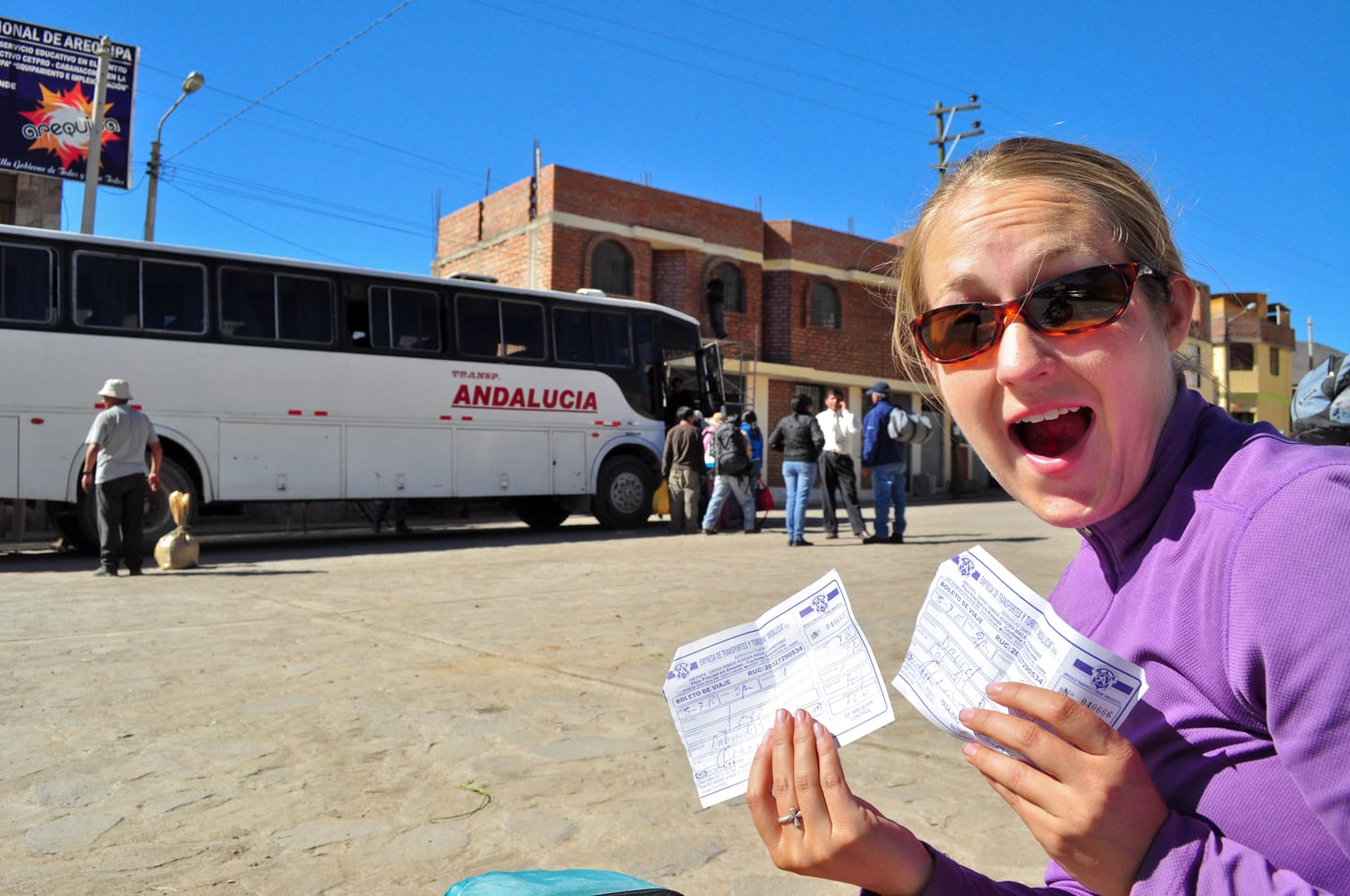
Part Five — Exploring Cabanaconde + Return Bus Journey to Arequipa
We’ve completed our climb out of one of the world’s deepest canyon, but our Colca Canyon trek isn’t over quite yet!
After arriving back in the village, the first item of business was to secure tickets for the return bus journey from Cabanaconde to Arequipa. Tickets in hand, we set out to explore a bit more of the village before our bus was due to depart.
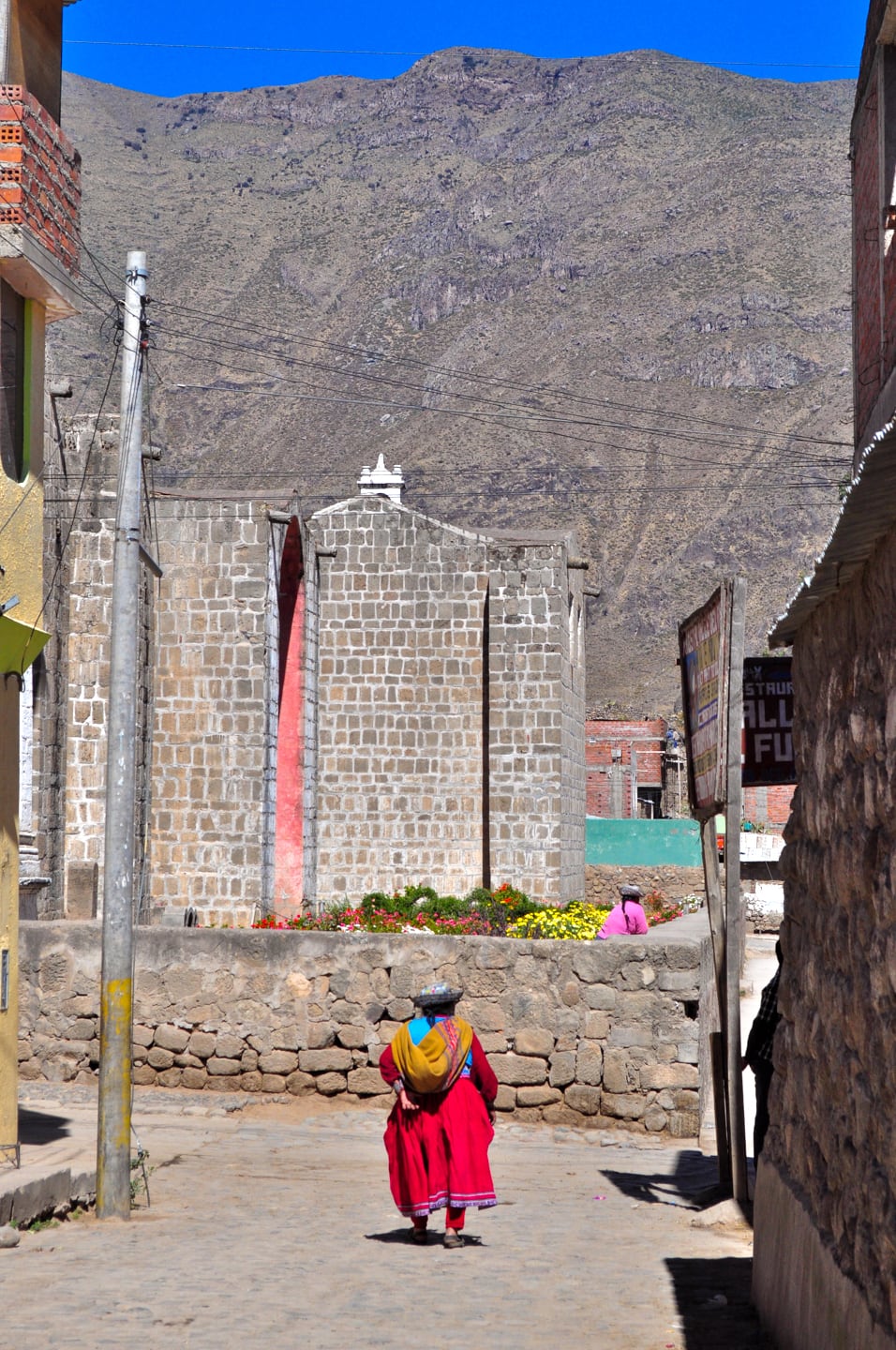
Stretching our legs is nice and all, but after our 3,000+ feet ascent, we were looking forward to resting them on the bus for six hours.
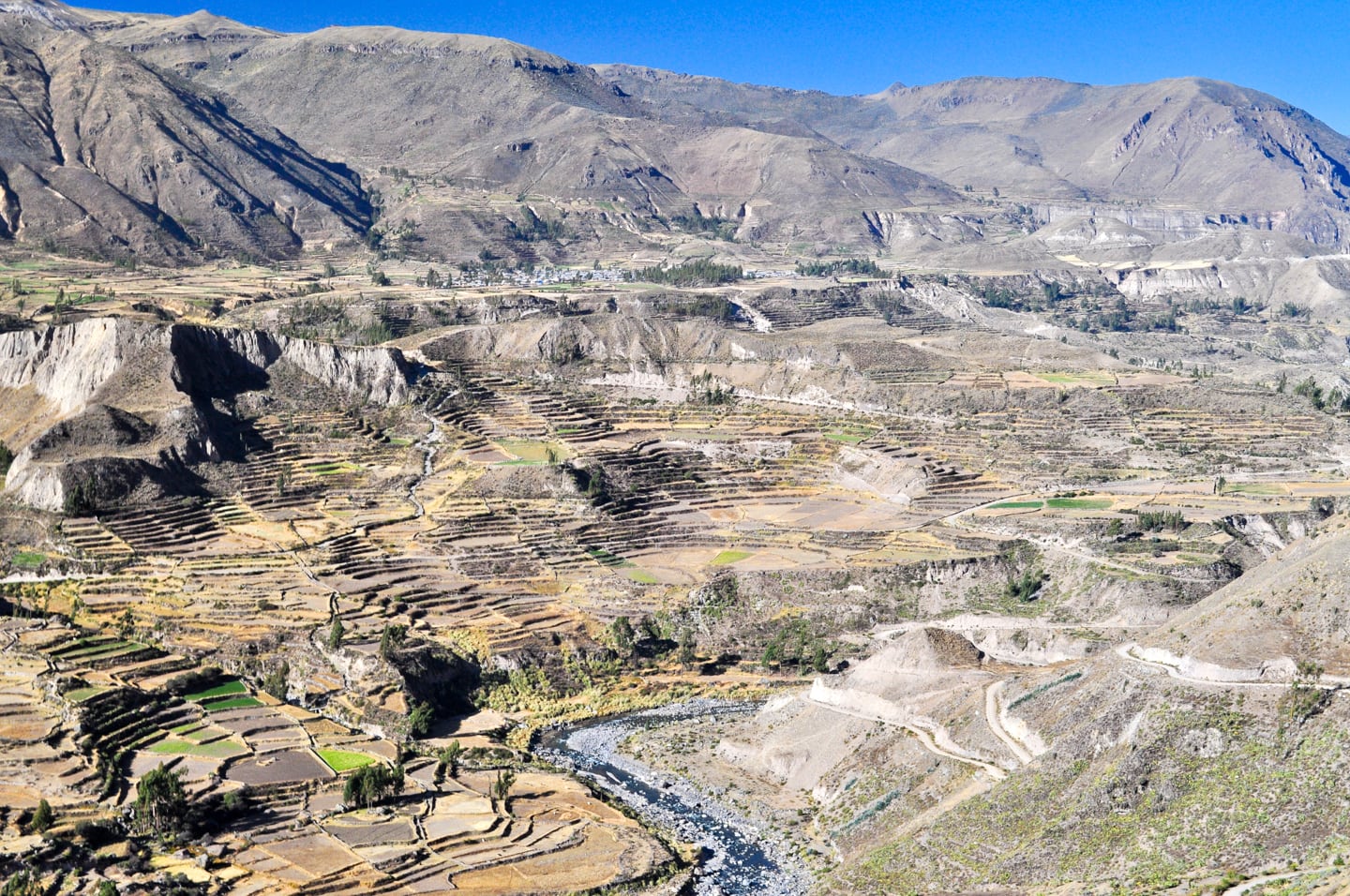
Back on the bus, we started the bumpy six-hour journey back to Arequipa.
During the first three hours, we caught the evening rush hour as the driver stopped every couple of minutes to pick up vendors, merchants, farmers, laborers, and school children and deposit them in one of four small villages we barreled through at breakneck speed.
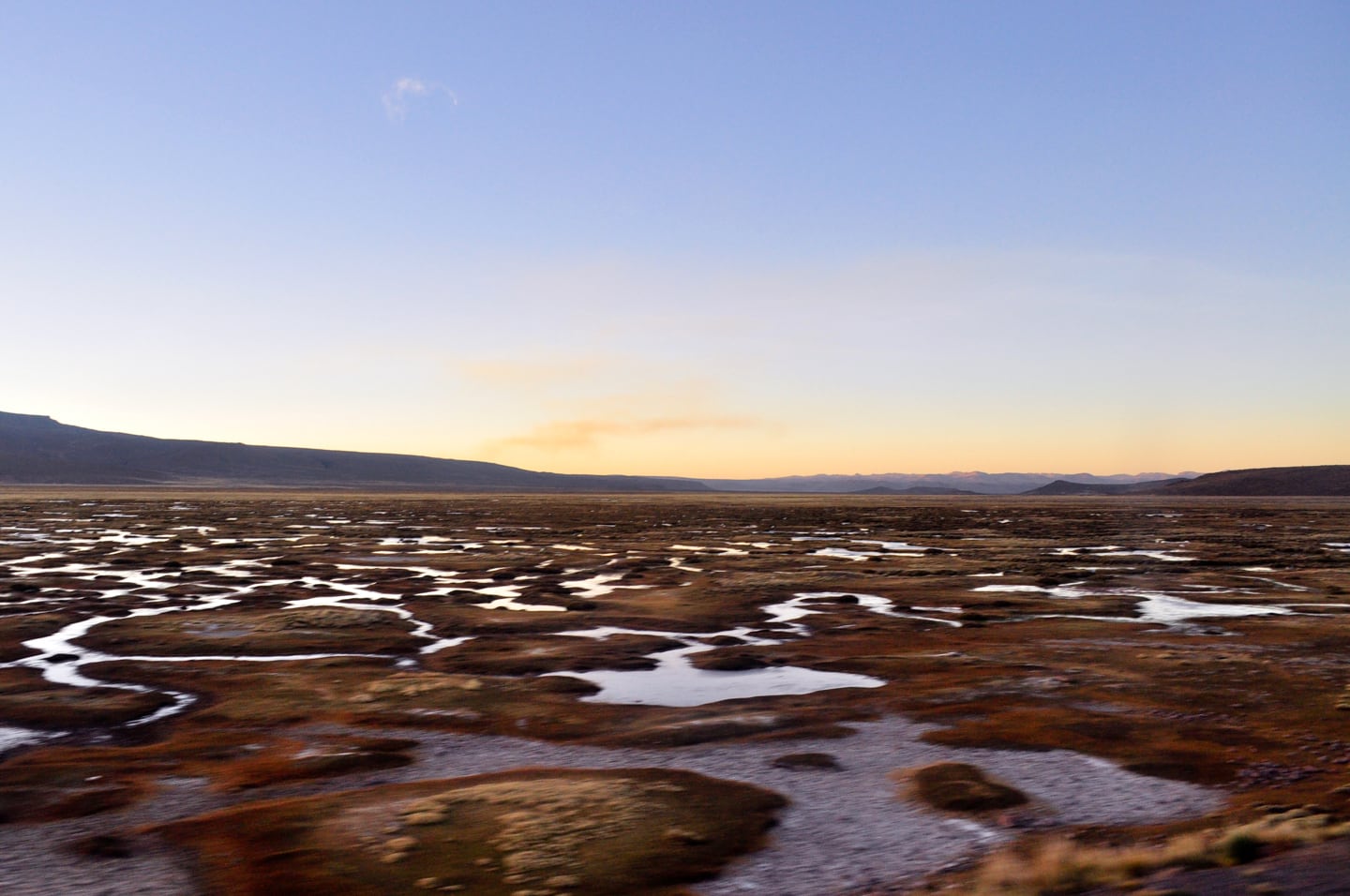
We spent the remainder of the journey following a long line of trucks on winding roads into Arequipa.
Once back in town, we checked into our guesthouse and prepared for our journey onward to Cuzco the next day, marking the official end of our amazing DIY Colca Canyon trek.
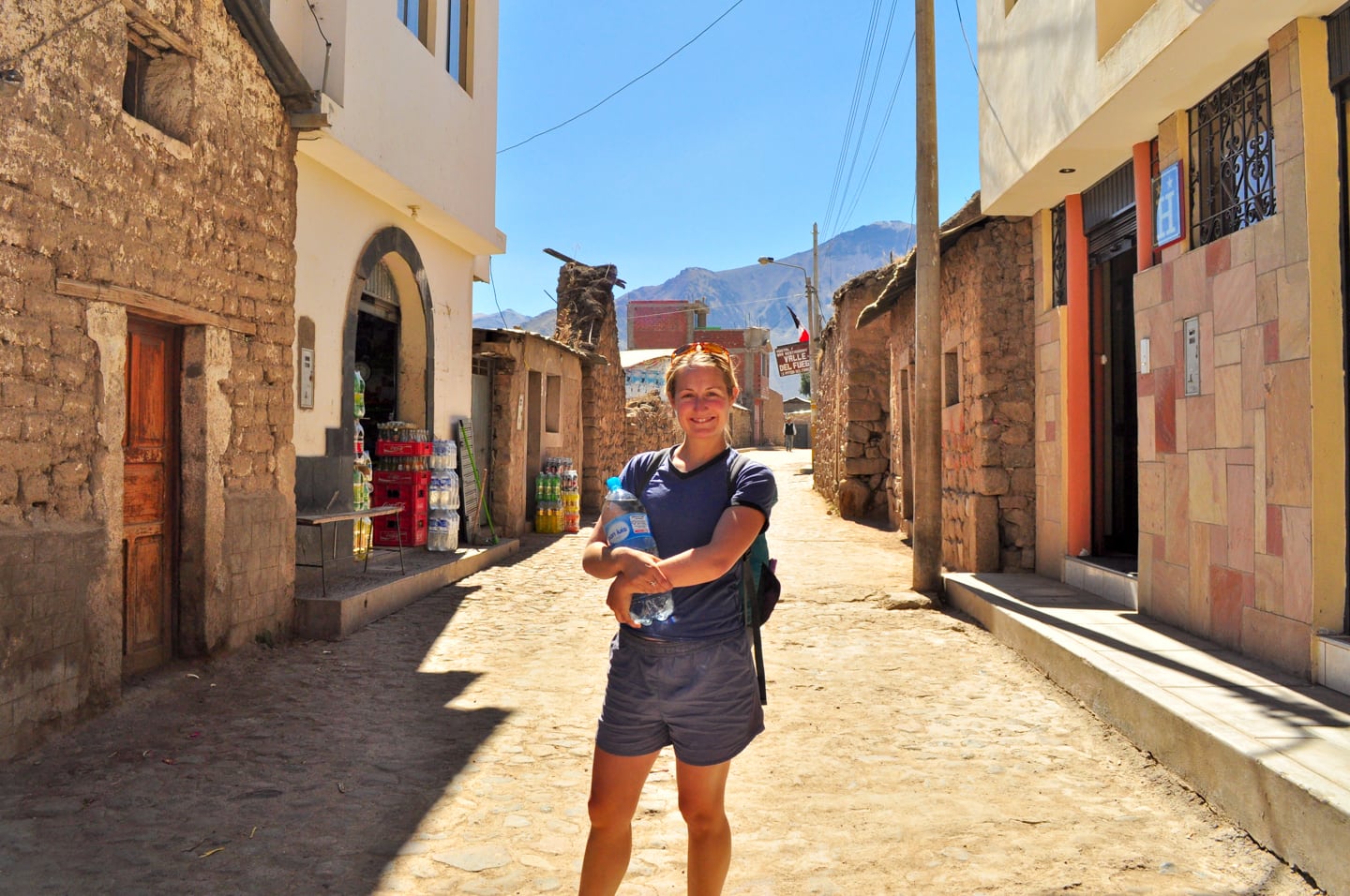
Is the Colca Canyon Trek Worth It?
We think so!
Whether you think it’s worth it will depend on your travel objectives, time constraints and flexibility, personal fitness level, threshold for punishment, and sense of adventure.
If we had it to do over again, we would’ve added a day or two for exploring the small villages hidden deep within the canyon. But if you’ve only got two days to explore the canyon, it’s still totally worth the effort for many travelers.
Who might find a Colca Canyon trek a complete disappointment? Well, if you’re looking for luxury accommodation with modern amenities, look elsewhere. You won’t find it on this trek.
And shaded trails? You won’t find many of those here either.
Porters, mules, or other services for carrying you or your stuff. Nope. Try the Inca Trail.
But if roughing it, getting in a rewarding workout, having genuine interactions with real people in this rural community, and taking in the breathtaking beauty of this supremely stunning natural wonder tend to appeal to you, then a Colca Canyon trek won’t disappoint!
More South America Inspiration
- Baños & Ruta de las Cascadas: A Traveler’s Guide
- Cuenca, Ecuador: Why Visit + What to Expect
- Colca Canyon Trekkers Guide
- The Peruvian Amazon: Iquitos, Mazán & Indiana
- Taquile Island (Isla Taquile) on Lake Titicaca
- Amantaní Island (Peru): Our Homestay Experience
- Uros Floating Islands of Lake Titicaca in Peru
- Cuzco, Peru: Capital of the Inca Empire
